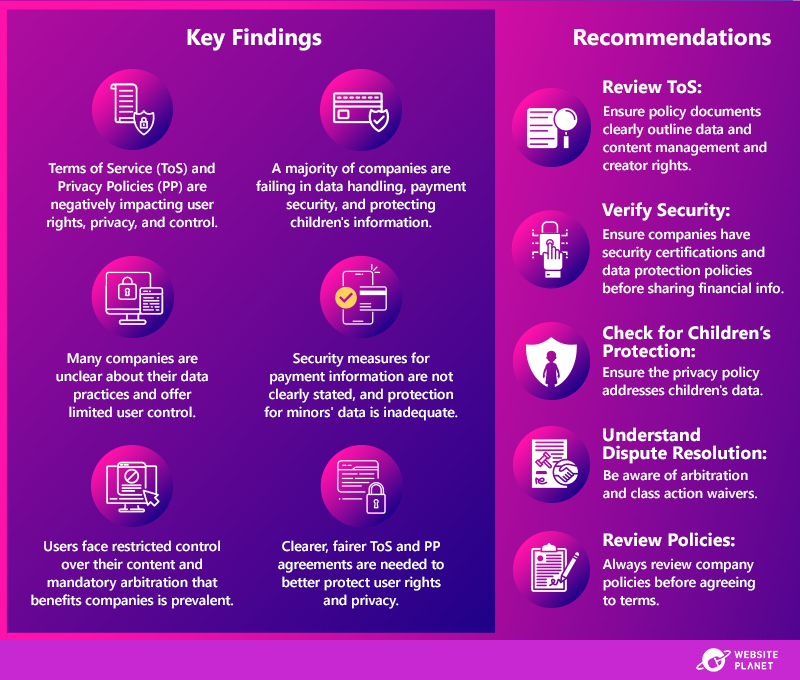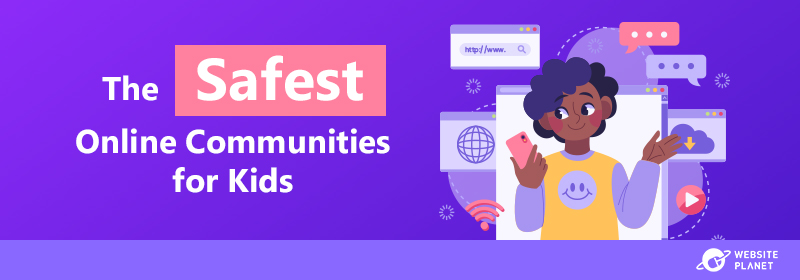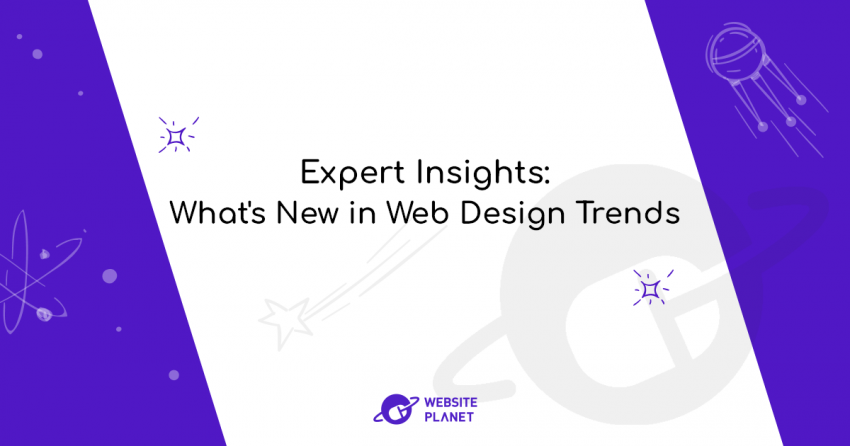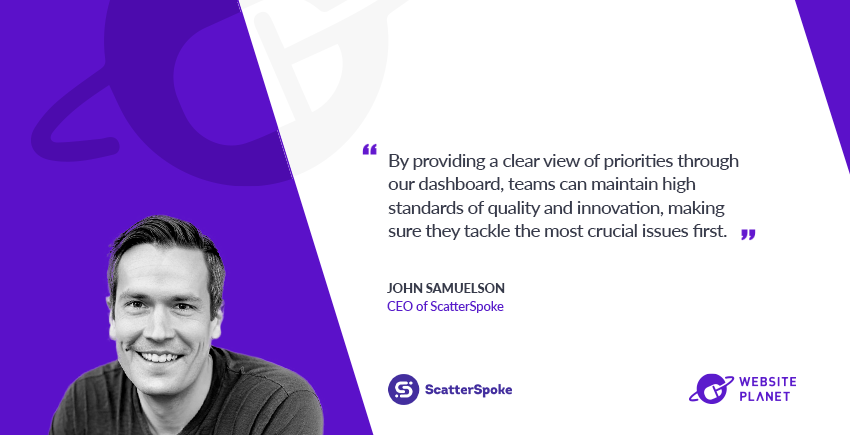Inside this Article
Instagram Marketing Overview
Let’s get this party started with a few general statistics and facts. You know, stuff like: the who, what, where, and when of Instagram usage. What’s hot and what’s not? And how many people are on Instagram, anyway?1. How Many People Are on Instagram?
 Instagram is home to well over 1.2 billion users in 2021.
No one could have predicted the platform’s rise to prominence since it was acquired by Facebook in 2012.
Instagram now ranks within the top 5 most popular social media sites around the world and has developed into a direct competitor to its bigger brother.
Instagram users are especially devoted. 500 million of them visit the app daily, and together they like 4.2 billion posts on average.
Instagram’s users post a lot, too. 1000 videos are uploaded every second on the platform, and 100 million photos and videos are uploaded every day.
Instagram is home to well over 1.2 billion users in 2021.
No one could have predicted the platform’s rise to prominence since it was acquired by Facebook in 2012.
Instagram now ranks within the top 5 most popular social media sites around the world and has developed into a direct competitor to its bigger brother.
Instagram users are especially devoted. 500 million of them visit the app daily, and together they like 4.2 billion posts on average.
Instagram’s users post a lot, too. 1000 videos are uploaded every second on the platform, and 100 million photos and videos are uploaded every day.
2. How Many Businesses Are on Instagram?
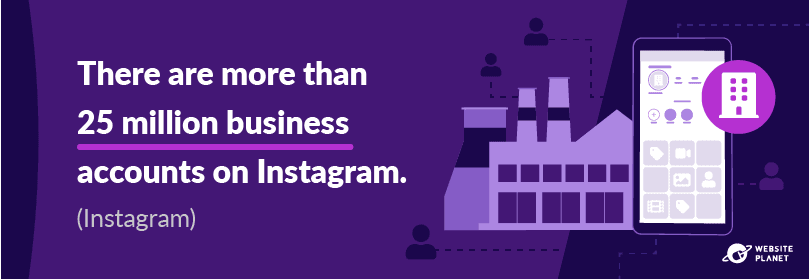 Instagram has become an accessible platform, and not only for your average user. Businesses have discovered the advantages of using Instagram as a way to market and generate leads with potential customers.
9/10 of the biggest companies in the world own and run an Instagram account. It’s pretty clear, then, that Instagram is a crucial platform for the majority of businesses.
Instagram has become an accessible platform, and not only for your average user. Businesses have discovered the advantages of using Instagram as a way to market and generate leads with potential customers.
9/10 of the biggest companies in the world own and run an Instagram account. It’s pretty clear, then, that Instagram is a crucial platform for the majority of businesses.
3. People Follow Their Favorite Brands on Instagram
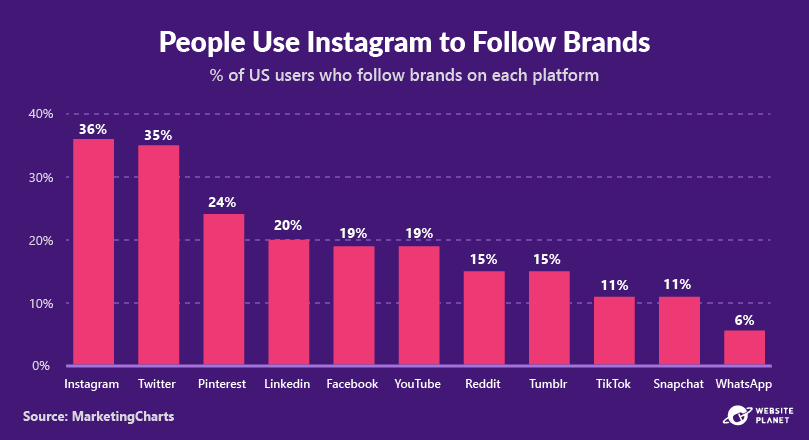 Instagram users actively want to follow their favorite brands, and that trend is more common for Instagram users than those on any other social network.
That’s why 90% of Instagram users follow businesses through the platform. Meanwhile, 200 million users out of Instagram’s 1.2 billion strong user base visit at least one business profile every day.
By following a business on Instagram, users can discuss their favorite brands with other users, or keep tabs on a brand’s promotional materials and products. The love people have for brands on Instagram potentially explains the next statistic.
Instagram users actively want to follow their favorite brands, and that trend is more common for Instagram users than those on any other social network.
That’s why 90% of Instagram users follow businesses through the platform. Meanwhile, 200 million users out of Instagram’s 1.2 billion strong user base visit at least one business profile every day.
By following a business on Instagram, users can discuss their favorite brands with other users, or keep tabs on a brand’s promotional materials and products. The love people have for brands on Instagram potentially explains the next statistic.
4. The Biggest Posts Feature Products
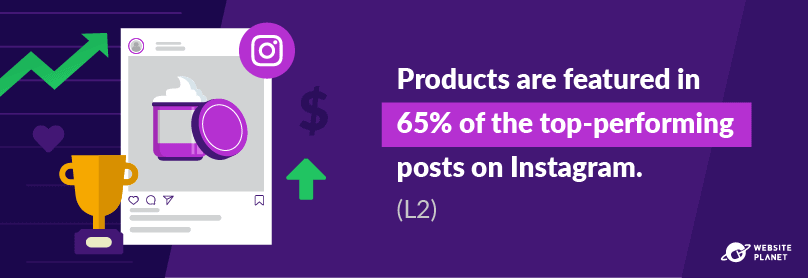 Business accounts can garner huge followings on Instagram, and people love to engage when they see something they like.
Most of the top posts on the platform are therefore product posts or posts that feature products.
That could be through paid promotion, or from a popular account posting a product that goes viral. The point is, when someone sees something they want on Instagram, they will view, like, share, or tag their friends in the post.
If it’s a shoppable post that provides a link to the product, users are likely to check that out too. 130 million Instagram users tap through shoppable posts every single month.
Business accounts can garner huge followings on Instagram, and people love to engage when they see something they like.
Most of the top posts on the platform are therefore product posts or posts that feature products.
That could be through paid promotion, or from a popular account posting a product that goes viral. The point is, when someone sees something they want on Instagram, they will view, like, share, or tag their friends in the post.
If it’s a shoppable post that provides a link to the product, users are likely to check that out too. 130 million Instagram users tap through shoppable posts every single month.
5. Instagram Leads to Sales
 This research from Facebook is valuable because it shows how Instagrammers use the platform to aid the buyer journey.
Users can find almost any brand or product by exploring hashtags and other accounts. All of this information is just a few clicks away, which makes Instagram the perfect research tool for prospective customers.
Instagram can provide such a wealth of information to users. That’s why it’s the place many of them go to make their purchasing decisions.
This research from Facebook is valuable because it shows how Instagrammers use the platform to aid the buyer journey.
Users can find almost any brand or product by exploring hashtags and other accounts. All of this information is just a few clicks away, which makes Instagram the perfect research tool for prospective customers.
Instagram can provide such a wealth of information to users. That’s why it’s the place many of them go to make their purchasing decisions.
6. Instagram Users Have Disposable Income
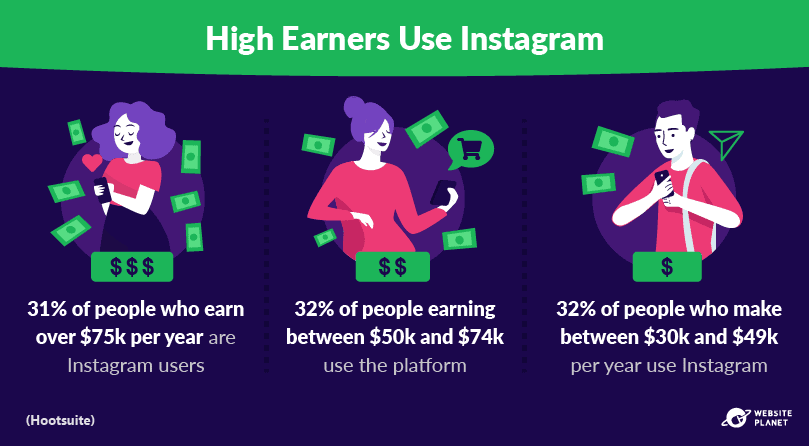 Let’s look into the demographics information on Instagram users. By knowing who’s using the platform, businesses can decide on a suitable course of action.
A large portion of Instagram users have a handsome income, and that should alert the attention of most entrepreneurs.
It is, perhaps, the reason why so many Instagram users are happy to purchase products on the platform. A lot of them have disposable income to burn, and can therefore afford to buy impulsively. Of course, “impulsive buying” is a phrase that marketers love to hear.
Let’s look into the demographics information on Instagram users. By knowing who’s using the platform, businesses can decide on a suitable course of action.
A large portion of Instagram users have a handsome income, and that should alert the attention of most entrepreneurs.
It is, perhaps, the reason why so many Instagram users are happy to purchase products on the platform. A lot of them have disposable income to burn, and can therefore afford to buy impulsively. Of course, “impulsive buying” is a phrase that marketers love to hear.
7. Instagram Users Are Young
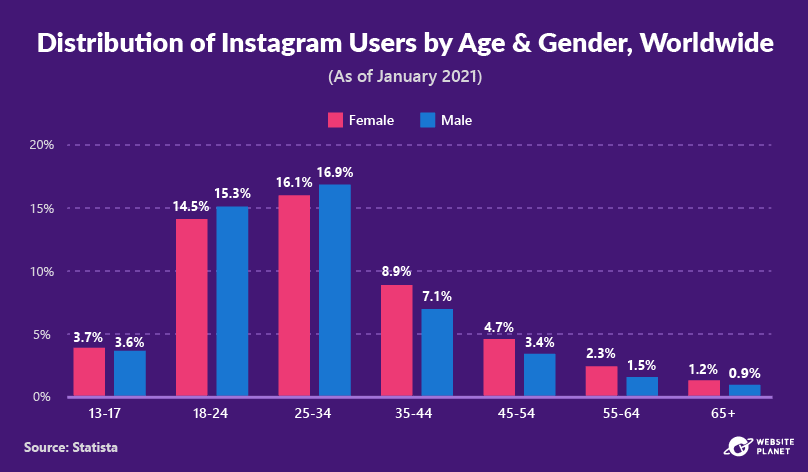 As with most social media platforms, Instagram’s user base is generally quite young.
Young adults make up the vast majority of Instagram’s users. The 25-34 age range accounts for around 33% of Instagram’s users. 18-24 is the next popular age bracket. Around 30% of Instagram’s user base falls into this category.
35 to 44-year-olds also have a significant presence on the platform, though users over the age of 44 are quite uncommon.
The data shows that — by a small percentage — Instagram’s user base skews female, too. 51% of Instagram users identify as female, while 49% identify as male.
As with most social media platforms, Instagram’s user base is generally quite young.
Young adults make up the vast majority of Instagram’s users. The 25-34 age range accounts for around 33% of Instagram’s users. 18-24 is the next popular age bracket. Around 30% of Instagram’s user base falls into this category.
35 to 44-year-olds also have a significant presence on the platform, though users over the age of 44 are quite uncommon.
The data shows that — by a small percentage — Instagram’s user base skews female, too. 51% of Instagram users identify as female, while 49% identify as male.
8. Teens Love Instagram
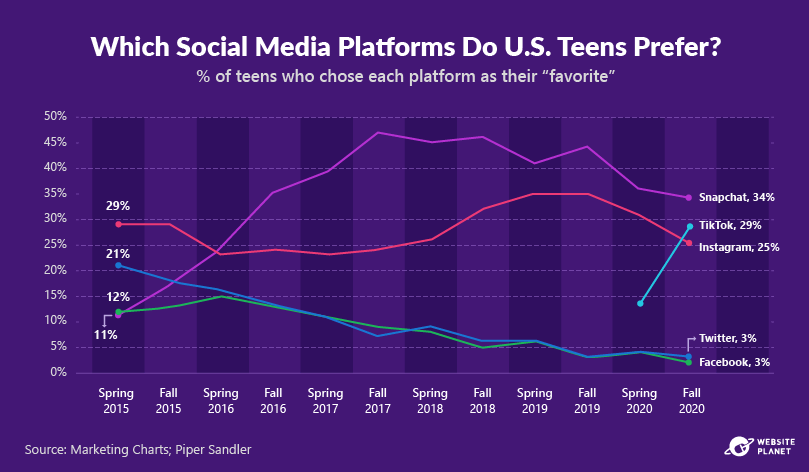 Instagram is especially popular amongst teens. In late 2020, 25% of U.S. teenagers in a Piper Sandler survey chose Instagram as their favorite social media platform. Instagram was beaten only by Snapchat, and the rising TikTok, for popularity amongst this age group.
In a similar survey by Wibbitz, 75% of Gen Zers say that Instagram is “one of” their favorite social media platforms.
The presence of engaging visual content, memes, and celebrity culture likely have a lot to do with Instagram’s usage amongst teens and Gen Zers. For marketers, this should throw up plenty of opportunities to reach a younger audience with their content.
Instagram is especially popular amongst teens. In late 2020, 25% of U.S. teenagers in a Piper Sandler survey chose Instagram as their favorite social media platform. Instagram was beaten only by Snapchat, and the rising TikTok, for popularity amongst this age group.
In a similar survey by Wibbitz, 75% of Gen Zers say that Instagram is “one of” their favorite social media platforms.
The presence of engaging visual content, memes, and celebrity culture likely have a lot to do with Instagram’s usage amongst teens and Gen Zers. For marketers, this should throw up plenty of opportunities to reach a younger audience with their content.
9. Where is Instagram Popular?
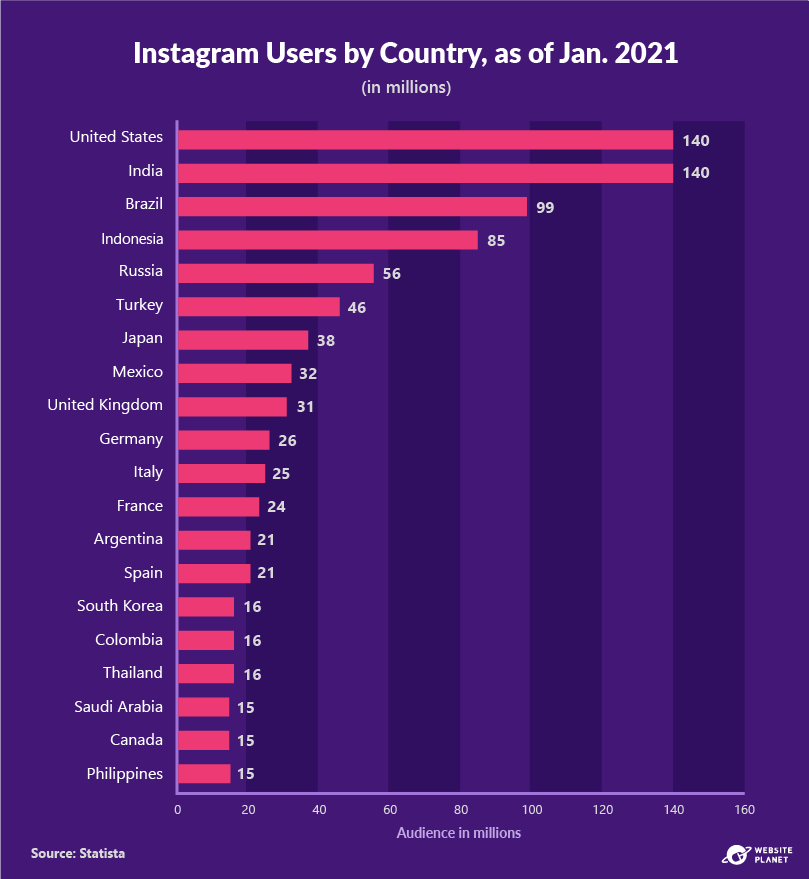 The United States of America is undoubtedly the number one hub for Instagram users. 140 million users are located in the states, that’s around 42% of the country’s population!
Instagram is equally popular around the world. India matches the USA for Instagram users, at 140 million, while 99 million users are from Brazil.
Indonesians love Instagram, too, with 85 million users, while Russia, Japan, and Turkey deserve an honorable mention. In total, 88% of Instagram’s user base is located outside of the United States.
Kazakhstan doesn’t feature on this list, but surprisingly it’s one of the most popular areas for Instagram among its smaller population. Instagram reaches 72% of the Kazakh population, which is a higher percentage than in any other nation.
The United States of America is undoubtedly the number one hub for Instagram users. 140 million users are located in the states, that’s around 42% of the country’s population!
Instagram is equally popular around the world. India matches the USA for Instagram users, at 140 million, while 99 million users are from Brazil.
Indonesians love Instagram, too, with 85 million users, while Russia, Japan, and Turkey deserve an honorable mention. In total, 88% of Instagram’s user base is located outside of the United States.
Kazakhstan doesn’t feature on this list, but surprisingly it’s one of the most popular areas for Instagram among its smaller population. Instagram reaches 72% of the Kazakh population, which is a higher percentage than in any other nation.
10. Ad Reach is Huge on Instagram
 Instagram’s expansive global user base means marketers can reach an eye-watering number of potential customers through the platform. 1.22 billion people can be reached by marketing materials on the platform.
Demographics information shows that 20% of people aged over 13 can be reached through Instagram marketing. That’s a staggering number of potential customers on a global scale.
Instagram’s expansive global user base means marketers can reach an eye-watering number of potential customers through the platform. 1.22 billion people can be reached by marketing materials on the platform.
Demographics information shows that 20% of people aged over 13 can be reached through Instagram marketing. That’s a staggering number of potential customers on a global scale.
11. Where Are Followers Distributed?
 Let’s take a look at follower distribution on Instagram. Overall, 53.6% of Instagram accounts have less than 1,000 followers.
The next common range for an account is between 1k-10k followers. Just 6.2% of accounts have 10k-50k followers, while 0.9% have 100k-500k.
The chart shows that getting into that higher bracket isn’t easy, but it is crucial if you want to market content to the biggest possible audience.
Let’s take a look at follower distribution on Instagram. Overall, 53.6% of Instagram accounts have less than 1,000 followers.
The next common range for an account is between 1k-10k followers. Just 6.2% of accounts have 10k-50k followers, while 0.9% have 100k-500k.
The chart shows that getting into that higher bracket isn’t easy, but it is crucial if you want to market content to the biggest possible audience.
12. Image Posts Are Most Common
 Image posts still dominate Instagram’s platform, with 66% of all posts consisting of a single image. After all, the platform was designed with static image posts in mind.
Although, carousel posts and video posts have experienced a rapid rise over the last few years.
Instagram has been busy implementing an array of video elements on its platform. Users can view static video posts, Stories, Instagram Lives, IGTVs, and Reels — which are an answer to TikTok’s popularization of short-form video.
Video posts on the platform now account for 14% of all posts, up from 9% in 2017.
Carousel posts have seen the biggest rise recently. According to Socialinsider, carousel posts have risen from non-existence in 2017 to now make up nearly 20% of all Instagram posts. Keep an eye on this trend for the coming years.
Image posts still dominate Instagram’s platform, with 66% of all posts consisting of a single image. After all, the platform was designed with static image posts in mind.
Although, carousel posts and video posts have experienced a rapid rise over the last few years.
Instagram has been busy implementing an array of video elements on its platform. Users can view static video posts, Stories, Instagram Lives, IGTVs, and Reels — which are an answer to TikTok’s popularization of short-form video.
Video posts on the platform now account for 14% of all posts, up from 9% in 2017.
Carousel posts have seen the biggest rise recently. According to Socialinsider, carousel posts have risen from non-existence in 2017 to now make up nearly 20% of all Instagram posts. Keep an eye on this trend for the coming years.
13. The Influencer Market is Growing
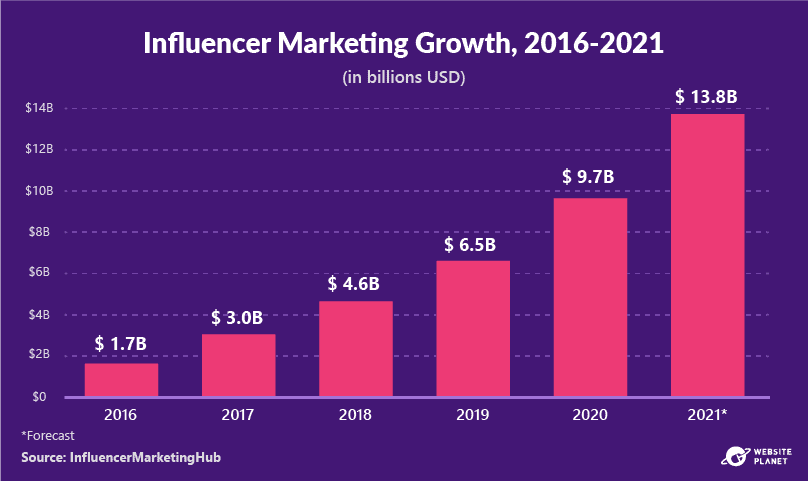 The influencer market is expected to see massive growth in 2021, which has been a continuing trend over the last few years.
Across all platforms, the influencer marketing industry will rise from $9.7B to $13.8B throughout 2021, a year-on-year increase of 42%.
Instagram has been the biggest beneficiary of rapid market growth in Influencer marketing. Between February 2018 and February 2019, the use of #ad increased by a whopping 133% on Instagram. That’s the hashtag influencers often use to signal a “paid promotion.”
Instagram has benefitted because it’s the best place for influencer marketing. Mediakix estimates that Instagram could be home to as many as 37 million influencers, more than any other social media platform.
Instagram influencer marketing is the best way to reach a female audience, too. 84% of social media influencers are female.
The influencer market is expected to see massive growth in 2021, which has been a continuing trend over the last few years.
Across all platforms, the influencer marketing industry will rise from $9.7B to $13.8B throughout 2021, a year-on-year increase of 42%.
Instagram has been the biggest beneficiary of rapid market growth in Influencer marketing. Between February 2018 and February 2019, the use of #ad increased by a whopping 133% on Instagram. That’s the hashtag influencers often use to signal a “paid promotion.”
Instagram has benefitted because it’s the best place for influencer marketing. Mediakix estimates that Instagram could be home to as many as 37 million influencers, more than any other social media platform.
Instagram influencer marketing is the best way to reach a female audience, too. 84% of social media influencers are female.
14. Engagement is Also Growing
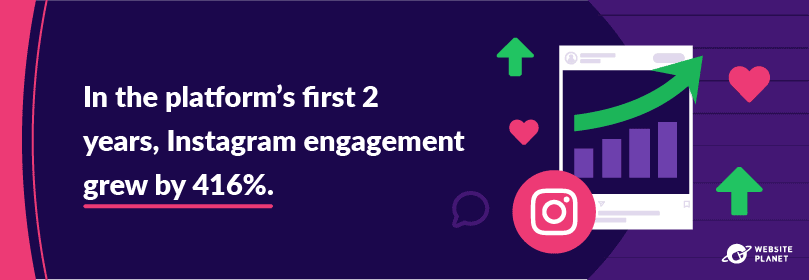 With tonnes of new users, interactive features, video types, and live content elements, it’s no surprise that Instagram has seen a rapid rise in engagement since it was first introduced.
Although Instagram engagement has declined slightly in recent years, Instagram still has a higher engagement rate than any other social media platform. As mentioned, Instagram’s new features are a big reason for this trend.
Wibbitz found that Instagram users now spend most of their time watching videos. 69% of it, to be exact. The platform has so many video elements.; why not try to utilize this theme in your social media marketing strategy?
With tonnes of new users, interactive features, video types, and live content elements, it’s no surprise that Instagram has seen a rapid rise in engagement since it was first introduced.
Although Instagram engagement has declined slightly in recent years, Instagram still has a higher engagement rate than any other social media platform. As mentioned, Instagram’s new features are a big reason for this trend.
Wibbitz found that Instagram users now spend most of their time watching videos. 69% of it, to be exact. The platform has so many video elements.; why not try to utilize this theme in your social media marketing strategy?
15. The Whole Platform is Growing
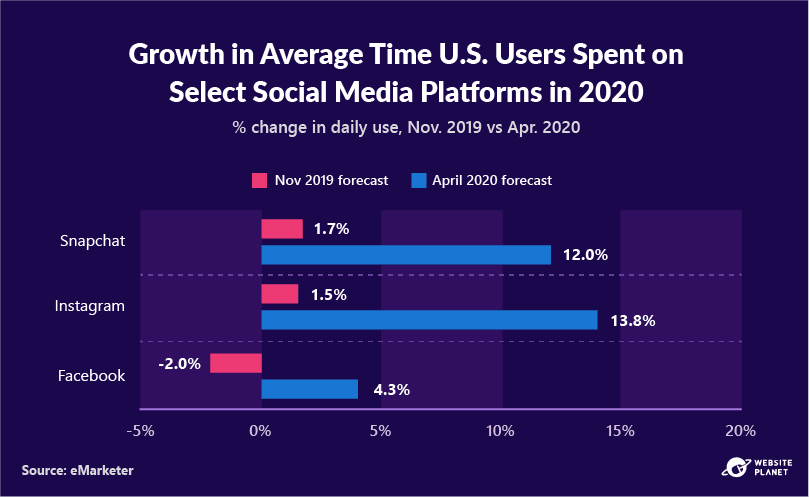 Pretty much every social media platform benefited massively from the recent COVID-19 lockdown. Not many could match the growth of Instagram, however.
Instagram received a staggering 500 million app downloads in 2020 and currently ranks as the 6th most visited website — despite prioritizing its app.
According to Recode, Instagrammers spend (on average) 53 minutes on the platform every day. Instagram users flocked to the platform during lockdown, too. Its array of content and video elements contributed to a 13.8% increase in usage among Instagram users.
Pretty much every social media platform benefited massively from the recent COVID-19 lockdown. Not many could match the growth of Instagram, however.
Instagram received a staggering 500 million app downloads in 2020 and currently ranks as the 6th most visited website — despite prioritizing its app.
According to Recode, Instagrammers spend (on average) 53 minutes on the platform every day. Instagram users flocked to the platform during lockdown, too. Its array of content and video elements contributed to a 13.8% increase in usage among Instagram users.
The Impact of Instagram Marketing
Now you’ve got a handle on the basic statistics, we’re going to have a look at some of the impact you can expect when marketing on Instagram. If you’re not completely sold on the idea, these stats should show you the true value of Instagram marketing.16. Instagram Is the Most Engaging Platform
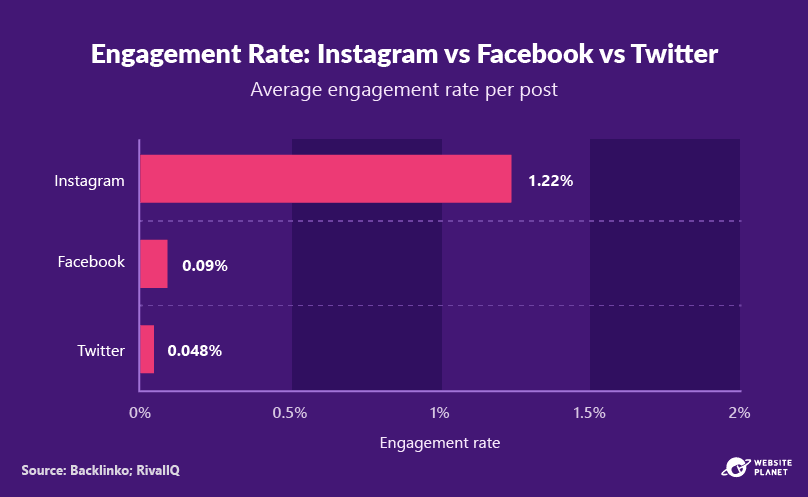 Instagram offers the highest engagement rate of any social media platform. You can see how it measures up to Facebook and Twitter in the above graphic.
To clarify: the “engagement rate” demonstrates the level of involvement an audience has with content on each platform. It outlines how often users view, like, share, and comment on each post.
Instagram users engage with content 1.22% of the time. That’s 13.5X higher than Facebook (0.09%) and a staggering 27X higher than Twitter (0.048%).
For business accounts, the engagement rate is slightly lower — but Instagram still offers far better engagement than Facebook and Twitter. Business accounts on Instagram have a median engagement rate of 0.98%, compared to Facebook’s 0.08% and Twitter’s 0.045%.
According to Instagram, 50% of users claim they are more interested in a company after seeing its advert on the platform, which is evident in the engagement brands on Instagram can expect.
Instagram offers the highest engagement rate of any social media platform. You can see how it measures up to Facebook and Twitter in the above graphic.
To clarify: the “engagement rate” demonstrates the level of involvement an audience has with content on each platform. It outlines how often users view, like, share, and comment on each post.
Instagram users engage with content 1.22% of the time. That’s 13.5X higher than Facebook (0.09%) and a staggering 27X higher than Twitter (0.048%).
For business accounts, the engagement rate is slightly lower — but Instagram still offers far better engagement than Facebook and Twitter. Business accounts on Instagram have a median engagement rate of 0.98%, compared to Facebook’s 0.08% and Twitter’s 0.045%.
According to Instagram, 50% of users claim they are more interested in a company after seeing its advert on the platform, which is evident in the engagement brands on Instagram can expect.
17. Shoppable Posts Boost Traffic
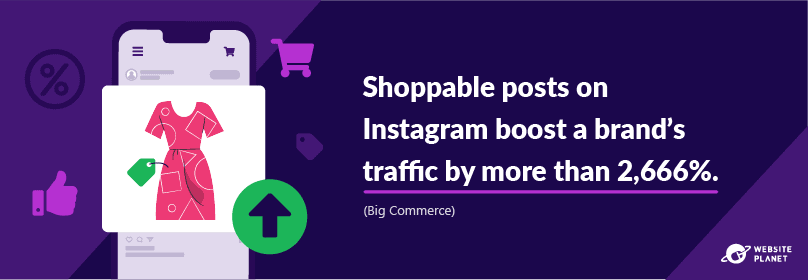 Shoppable posts are popular amongst brands right now. In particular, shoppable posts work well for retail brands, as they can provide links to the products shown in the image.
Shoppable posts are a good idea for almost any brand in reality. Shoppable posts provide a direct link to your business on-screen, so when someone sees something they like, they can click on the product and go straight to your site or Instagram retail portal.
That’s why shoppable posts boost brand traffic by well over 2,500%. That’s pretty amazing.
Shoppable posts are popular amongst brands right now. In particular, shoppable posts work well for retail brands, as they can provide links to the products shown in the image.
Shoppable posts are a good idea for almost any brand in reality. Shoppable posts provide a direct link to your business on-screen, so when someone sees something they like, they can click on the product and go straight to your site or Instagram retail portal.
That’s why shoppable posts boost brand traffic by well over 2,500%. That’s pretty amazing.
18. Instagram Gets Better Conversions and Order Value
 These statistics from AOV show that Instagram is the king of high-value conversions.
As mentioned, there are some high-earners on Instagram, and users generally love to spend their cash on the platform. 50% of Instagram users say they have become more interested in a company or brand after seeing an ad on Instagram (Hubspot).
That explains the ultra-high conversion rate of 0.41% for paid social media posts and 1.18% for unpaid social media posts. Those conversion stats are second only to Facebook, and far better than Pinterest and Snapchat.
What’s more, Instagram drives some of the highest order value compared to other platforms. Users who convert spend, on average, $103 for paid conversions and $65 for unpaid conversions.
That’s more than Snapchat and Facebook, and slightly less than Pinterest.
These statistics from AOV show that Instagram is the king of high-value conversions.
As mentioned, there are some high-earners on Instagram, and users generally love to spend their cash on the platform. 50% of Instagram users say they have become more interested in a company or brand after seeing an ad on Instagram (Hubspot).
That explains the ultra-high conversion rate of 0.41% for paid social media posts and 1.18% for unpaid social media posts. Those conversion stats are second only to Facebook, and far better than Pinterest and Snapchat.
What’s more, Instagram drives some of the highest order value compared to other platforms. Users who convert spend, on average, $103 for paid conversions and $65 for unpaid conversions.
That’s more than Snapchat and Facebook, and slightly less than Pinterest.
19. Instagram Stories Are Engaging
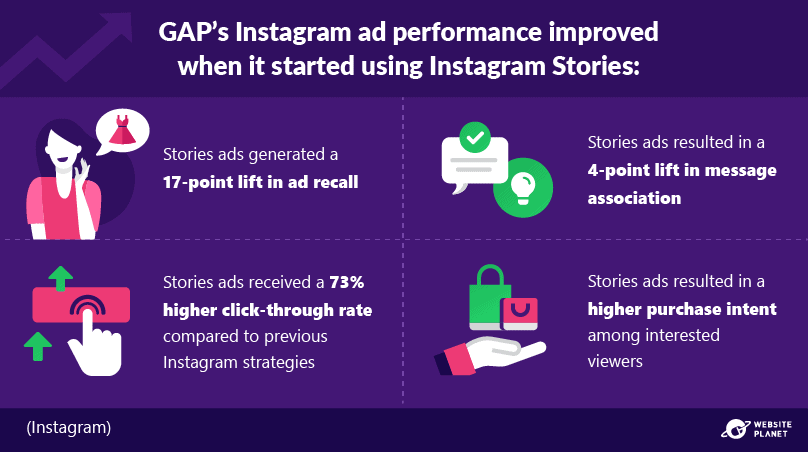 A case study from GAP demonstrates the potential upsides that Instagram Stories can have for your business.
When GAP started marketing through this channel, the lift in performance across a range of metrics was staggering.
GAP’s Stories campaign saw an increase in “ad recall” (i.e. the number of people who remembered their ad) of 17 points. On top of that, GAP’s campaign saw an increase in message association by 4 points — which means users could relate the advertising message they heard back to GAP better than before.
GAP’s Stories increased the click-through rate by a whopping 73% as well, and these users intended to make a purchase more often than before.
The benefits of Stories should come as no surprise. An Instagram study found that 58% of people have become more interested in a brand when they’ve viewed its materials/products on Instagram Stories. Another 50% of users visited a brand’s website to make a purchase after seeing an ad on Stories.
It’s a pretty crucial part of Instagram marketing, then. If you’re not utilizing Stories, you’re missing out.
A case study from GAP demonstrates the potential upsides that Instagram Stories can have for your business.
When GAP started marketing through this channel, the lift in performance across a range of metrics was staggering.
GAP’s Stories campaign saw an increase in “ad recall” (i.e. the number of people who remembered their ad) of 17 points. On top of that, GAP’s campaign saw an increase in message association by 4 points — which means users could relate the advertising message they heard back to GAP better than before.
GAP’s Stories increased the click-through rate by a whopping 73% as well, and these users intended to make a purchase more often than before.
The benefits of Stories should come as no surprise. An Instagram study found that 58% of people have become more interested in a brand when they’ve viewed its materials/products on Instagram Stories. Another 50% of users visited a brand’s website to make a purchase after seeing an ad on Stories.
It’s a pretty crucial part of Instagram marketing, then. If you’re not utilizing Stories, you’re missing out.
20. Brand Stories Promote Engagement
 The “completion rate” is like a “conversion rate.” It’s the rate at which a brand gets users to answer a call-to-action, such as a “swipe up” call or “rate this” bar in the case of Instagram Stories.
People are receptive to Instagram Stories. They won’t exactly do whatever brands tell them, but certainly the channel promotes some curiosity amongst users. Mention found that 7 out of every 10 Instagram users have answered a brand’s “swipe up” call on stories to access a link.
The “completion rate” is like a “conversion rate.” It’s the rate at which a brand gets users to answer a call-to-action, such as a “swipe up” call or “rate this” bar in the case of Instagram Stories.
People are receptive to Instagram Stories. They won’t exactly do whatever brands tell them, but certainly the channel promotes some curiosity amongst users. Mention found that 7 out of every 10 Instagram users have answered a brand’s “swipe up” call on stories to access a link.
21. Influencer Posts Engage on Instagram
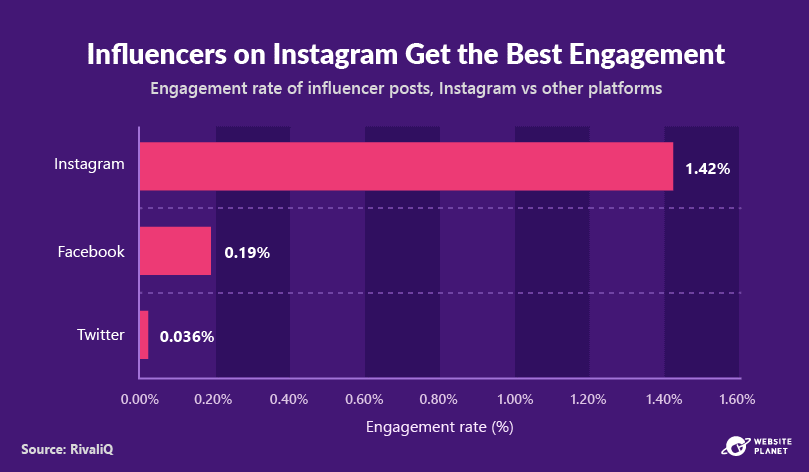 Instagram is the most engaging social media platform, and so it stands to reason that influencers also get more engagement on Instagram than they do on other platforms.
According to Rival IQ, influencer posts on Instagram get an engagement rate of 1.42%. That’s far higher than Facebook (0.19%) or Twitter (0.036%).
Instagram says that 87% of users on its platform have been driven to make a purchase by an influencer. This ultra-high engagement explains why Instagram is the most popular platform for influencer marketers.
Instagram is the most engaging social media platform, and so it stands to reason that influencers also get more engagement on Instagram than they do on other platforms.
According to Rival IQ, influencer posts on Instagram get an engagement rate of 1.42%. That’s far higher than Facebook (0.19%) or Twitter (0.036%).
Instagram says that 87% of users on its platform have been driven to make a purchase by an influencer. This ultra-high engagement explains why Instagram is the most popular platform for influencer marketers.
22. IGTV is Less Engaging
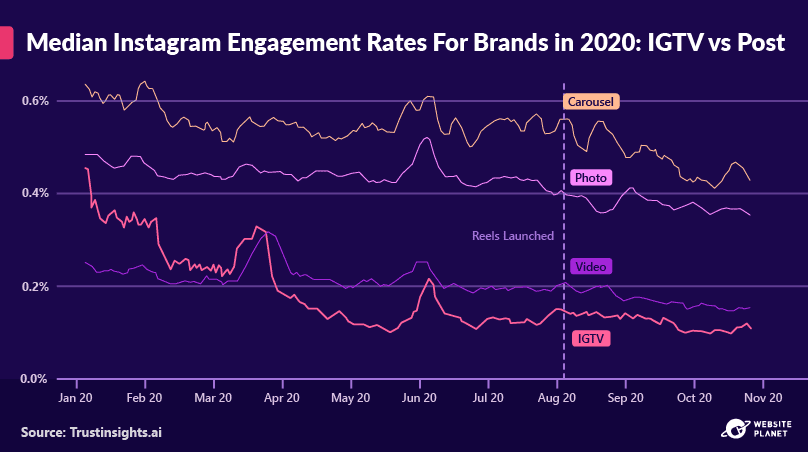 IGTV is the least impactful form of video on Instagram at this moment in time. In a Trust Insights study, it had a lower engagement rate for brands compared to video, photo, and carousel posts.
This is in light of a decrease in engagement across all 4 channels in 2020, caused in part by the introduction of Reels and various other media elements.
Nonetheless, IGTV saw the biggest decline in engagement in 2020. IGTV declined by 75.6%, while carousels (32.5%), photos (26.7%), and videos (39.3%) also saw a decrease in user engagement. Influencers fared better than most on IGTV with a 45.5% decline in engagement.
Don’t be overly alarmed, however, users are simply sharing their engagement across a range of channels. Instagram engagement remains extremely high overall.
While IGTV might be in short-term decline, I wouldn’t count it out completely. Instagram is constantly adding new features to IGTV, and plans on opening the platform up to advertising revenue to promote a community of long-form content creators.
Instagram hopes IGTV will be able to rival YouTube in the future, which could be hugely significant. According to the Pew Research Center, 95% of IGTV users also watch YouTube.
IGTV is the least impactful form of video on Instagram at this moment in time. In a Trust Insights study, it had a lower engagement rate for brands compared to video, photo, and carousel posts.
This is in light of a decrease in engagement across all 4 channels in 2020, caused in part by the introduction of Reels and various other media elements.
Nonetheless, IGTV saw the biggest decline in engagement in 2020. IGTV declined by 75.6%, while carousels (32.5%), photos (26.7%), and videos (39.3%) also saw a decrease in user engagement. Influencers fared better than most on IGTV with a 45.5% decline in engagement.
Don’t be overly alarmed, however, users are simply sharing their engagement across a range of channels. Instagram engagement remains extremely high overall.
While IGTV might be in short-term decline, I wouldn’t count it out completely. Instagram is constantly adding new features to IGTV, and plans on opening the platform up to advertising revenue to promote a community of long-form content creators.
Instagram hopes IGTV will be able to rival YouTube in the future, which could be hugely significant. According to the Pew Research Center, 95% of IGTV users also watch YouTube.
23. Reels Make a Big Impact
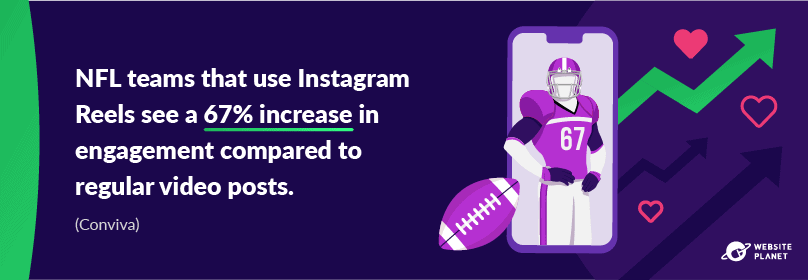 Instagram Reels is a brand new platform, and as such, there’s a distinct lack of research on the topic. That being said, Conviva’s study gives us valuable insight into the impact the platform can have.
Conviva found that American Football teams switching to the platform generated 67% better engagement compared to regular video posts on the Instagram feed. The NFL team that saw the greatest success was the New England Patriots. The Patriots increased engagements from 21,600 per video to 121,800 engagements per Reel.
That’s a huge jump, and owes to the popularity of short-form content in 2021. The platform uses a behavioral algorithm to recommend Reels to specific Instagram users. That makes Reels a fantastic choice for sports teams, and a viable option to any business or influencer that wants to spread their message.
Instagram Reels is a brand new platform, and as such, there’s a distinct lack of research on the topic. That being said, Conviva’s study gives us valuable insight into the impact the platform can have.
Conviva found that American Football teams switching to the platform generated 67% better engagement compared to regular video posts on the Instagram feed. The NFL team that saw the greatest success was the New England Patriots. The Patriots increased engagements from 21,600 per video to 121,800 engagements per Reel.
That’s a huge jump, and owes to the popularity of short-form content in 2021. The platform uses a behavioral algorithm to recommend Reels to specific Instagram users. That makes Reels a fantastic choice for sports teams, and a viable option to any business or influencer that wants to spread their message.
24. IGTVs and Reels Feature on “Explore”
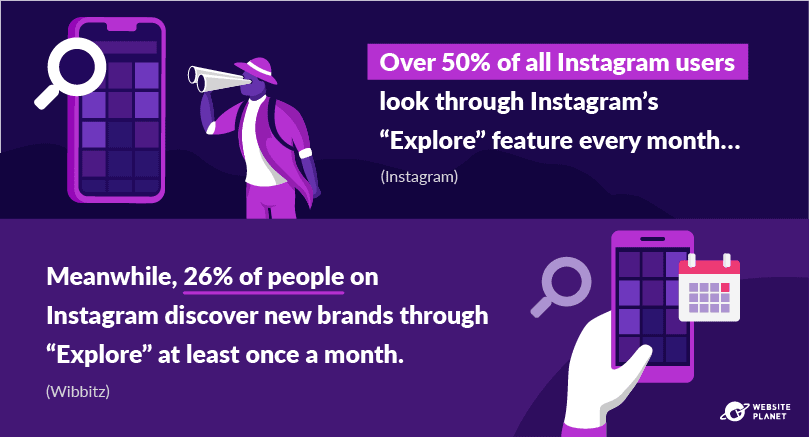 Reels and IGTVs get heavily featured on Instagram’s “Explore” page, so utilizing these two platforms could see great returns on brand awareness.
IGTV videos are actually 4X bigger than other featured posts on “Explore.” All the more reason we could see IGTV gain in popularity soon.
Reels and IGTVs get heavily featured on Instagram’s “Explore” page, so utilizing these two platforms could see great returns on brand awareness.
IGTV videos are actually 4X bigger than other featured posts on “Explore.” All the more reason we could see IGTV gain in popularity soon.
25. IG Live Holds Attention
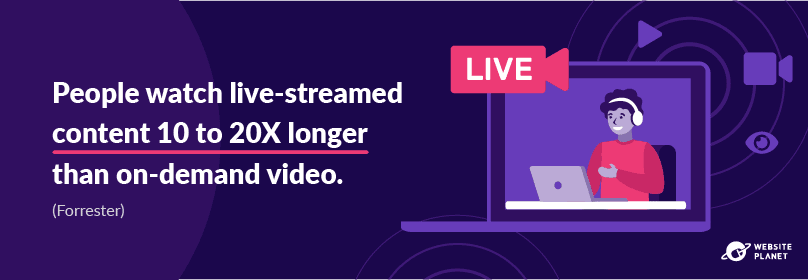 Live content has a long list of potential upsides for influencers and businesses. Not only does live content promote high levels of engagement, but viewers stick around for longer, too.
Instagram Live allows viewers to get closer to your brand, with live events, instant reaction, and functionality features (such as live comments) that encourage account-to-user interaction.
82% of viewers in a Livestream survey said they prefer seeing live streams from brands rather than social posts. Meanwhile, 47% of live stream viewers watch more live videos now than they did a year ago (Interactive Advertising Bureau).
The benefits of the platform are driving massive growth amongst businesses as well. It’s worth noting that Instagram Live bumps an account’s stream to the front of the queue on Instagram Stories. Just another reason Instagram Live usage increased by 70% in April 2020 (Business Insider).
Live content has a long list of potential upsides for influencers and businesses. Not only does live content promote high levels of engagement, but viewers stick around for longer, too.
Instagram Live allows viewers to get closer to your brand, with live events, instant reaction, and functionality features (such as live comments) that encourage account-to-user interaction.
82% of viewers in a Livestream survey said they prefer seeing live streams from brands rather than social posts. Meanwhile, 47% of live stream viewers watch more live videos now than they did a year ago (Interactive Advertising Bureau).
The benefits of the platform are driving massive growth amongst businesses as well. It’s worth noting that Instagram Live bumps an account’s stream to the front of the queue on Instagram Stories. Just another reason Instagram Live usage increased by 70% in April 2020 (Business Insider).
Instagram Marketing Trends
In section 3, we’ll take a look at marketing trends. These are trends amongst businesses, marketers, and influencers. What platforms are marketers using? What types of Instagram posts do businesses use? And which businesses and industries perform best on Instagram?26. How Popular is Instagram Amongst Marketers?
 Instagram is the second most popular social media platform amongst marketers, according to recent research from Social Media Examiner.
78% of all marketers use Instagram, slightly less than Facebook (93%) yet significantly more than other platforms like LinkedIn and YouTube.
Facebook and Instagram are the two most important platforms for marketers by some distance. Instagram has become more popular in the last year, with 76% of marketers using Instagram in 2020.
It looks as though Instagram will continue to be used in the future, too. The same study from Social Media Examiner also found that 72% of marketers plan to escalate their use of the platform heading forward.
Instagram is the second most popular social media platform amongst marketers, according to recent research from Social Media Examiner.
78% of all marketers use Instagram, slightly less than Facebook (93%) yet significantly more than other platforms like LinkedIn and YouTube.
Facebook and Instagram are the two most important platforms for marketers by some distance. Instagram has become more popular in the last year, with 76% of marketers using Instagram in 2020.
It looks as though Instagram will continue to be used in the future, too. The same study from Social Media Examiner also found that 72% of marketers plan to escalate their use of the platform heading forward.
27. How Many Marketers Use Instagram Stories?
 Instagram Stories checks out as the most popular place for marketing stories/short-form
video in 2021. Again, marketers love to post on Instagram and Facebook more than any other platform, with 59% and 53% of marketers using each site respectively.
Surprisingly, TikTok features low on the list, with just 9% of marketers using the burgeoning new social media platform to disseminate their short-form content.
Instagram Stories has seen a rapid rise in popularity amongst marketers over the last year. Just 46% of marketers used the platform in 2020, 13% lower than the figure in 2021.
Instagram Stories checks out as the most popular place for marketing stories/short-form
video in 2021. Again, marketers love to post on Instagram and Facebook more than any other platform, with 59% and 53% of marketers using each site respectively.
Surprisingly, TikTok features low on the list, with just 9% of marketers using the burgeoning new social media platform to disseminate their short-form content.
Instagram Stories has seen a rapid rise in popularity amongst marketers over the last year. Just 46% of marketers used the platform in 2020, 13% lower than the figure in 2021.
28. How Many Marketers Use Instagram Live?
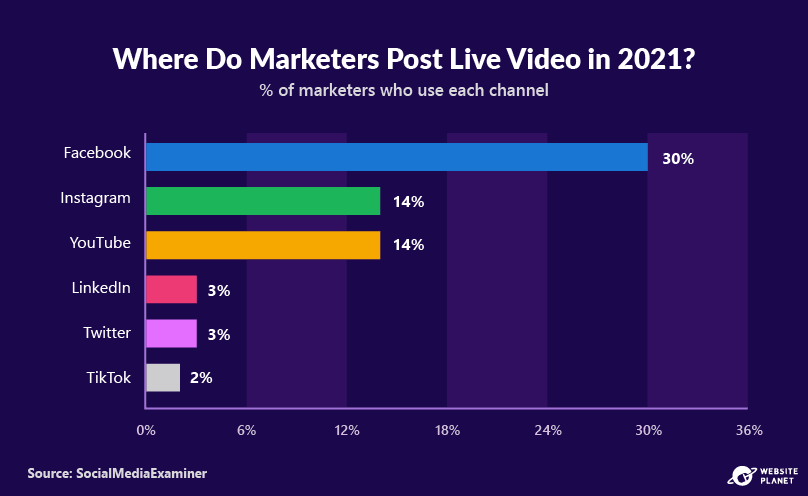 Facebook Live dominates the live video marketing landscape, with 30% of marketers using the platform to live stream video content.
Instagram still comes second amongst all platforms, however, tied with YouTube for usage amongst marketers. 14% of marketers use these 2 platforms.
Facebook Live and Instagram Live have seen declines since Social Media Examiner’s 2020 survey. Facebook has declined from 38%, while Instagram has declined from 17%. However, both platforms still lead all others despite these changes.
Facebook Live dominates the live video marketing landscape, with 30% of marketers using the platform to live stream video content.
Instagram still comes second amongst all platforms, however, tied with YouTube for usage amongst marketers. 14% of marketers use these 2 platforms.
Facebook Live and Instagram Live have seen declines since Social Media Examiner’s 2020 survey. Facebook has declined from 38%, while Instagram has declined from 17%. However, both platforms still lead all others despite these changes.
29. Marketers Blow Their Budget on Instagram
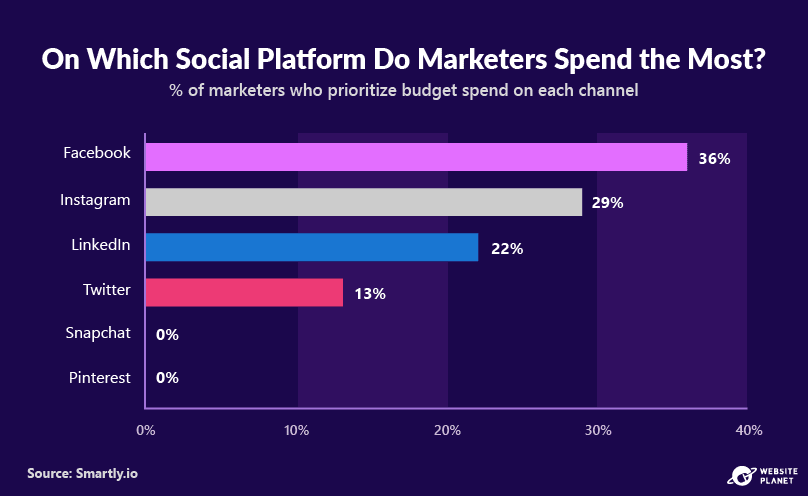 Given Instagram’s popularity amongst marketers, and the results many of them wield from the platform, it would only be right that marketers spend a lot of money on Instagram.
According to Smartly.io, 29% of marketers prioritize their advertising spend on Instagram. It makes sense. Instagram has so many different channels to use that it’s perfect for a marketer’s content strategy.
They can place an array of content in the eyeline of the consumer, and the platform’s engagement means the return-on-investment is likely to be substantial.
Given Instagram’s popularity amongst marketers, and the results many of them wield from the platform, it would only be right that marketers spend a lot of money on Instagram.
According to Smartly.io, 29% of marketers prioritize their advertising spend on Instagram. It makes sense. Instagram has so many different channels to use that it’s perfect for a marketer’s content strategy.
They can place an array of content in the eyeline of the consumer, and the platform’s engagement means the return-on-investment is likely to be substantial.
30. It’s Getting Cheaper to Market on Instagram
 CPC or “cost-per-click” is a measure of the expense/success of a marketer’s strategy online. It outlines the price businesses pay for each acquisition/click on their ad.
Instagram has traditionally been one of the more expensive places to market, leading to a reluctance to utilize the platform by some marketers.
Thankfully, the CPC on Instagram has fallen significantly in recent times. For ads on feeds, CPC fell by 20% year-on-year in Q3 of 2020. In the same quarter, the CPC for Instagram Stories fell by 15% year-on-year.
This means it is now more cost-effective to market on Instagram than it ever has been before.
This is partly because of the fantastic return on investment brands now get from Instagram marketing, as well as the increasing popularity of the platform.
As the average CPC continues to fall, expect more marketers to take note, targeting Instagram users with their marketing strategy.
CPC or “cost-per-click” is a measure of the expense/success of a marketer’s strategy online. It outlines the price businesses pay for each acquisition/click on their ad.
Instagram has traditionally been one of the more expensive places to market, leading to a reluctance to utilize the platform by some marketers.
Thankfully, the CPC on Instagram has fallen significantly in recent times. For ads on feeds, CPC fell by 20% year-on-year in Q3 of 2020. In the same quarter, the CPC for Instagram Stories fell by 15% year-on-year.
This means it is now more cost-effective to market on Instagram than it ever has been before.
This is partly because of the fantastic return on investment brands now get from Instagram marketing, as well as the increasing popularity of the platform.
As the average CPC continues to fall, expect more marketers to take note, targeting Instagram users with their marketing strategy.
31. What Type of Posts Do Businesses Use?
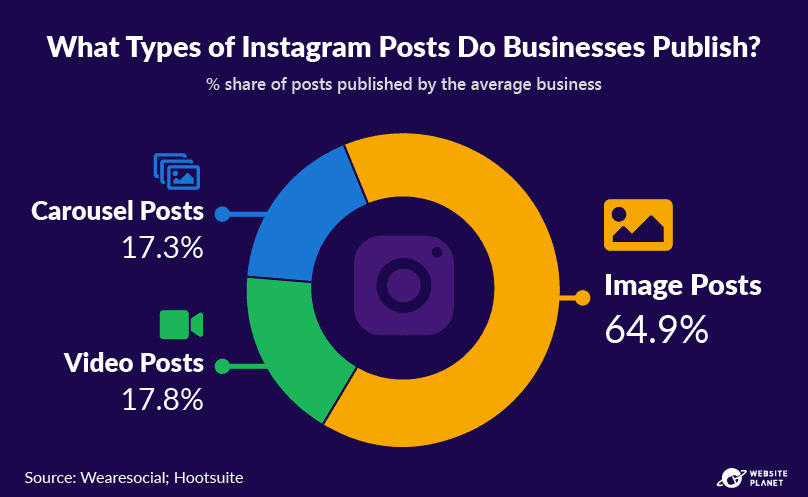 According to research from Hootsuite, the average business posts 1.56 times every day.
Businesses normally prioritize image posts as part of their Instagram content strategy. Image posts make up 64.9% of the content a business posts, on average.
Video posts are published around 18% of the time and carousel posts make up 17% of a business’s content on the platform.
These patterns allow the average business account to grow its following by 1.68% every month.
This figure could potentially be higher if businesses prioritized videos and carousels — these 2 post types attract higher levels of engagement than static images.
According to research from Hootsuite, the average business posts 1.56 times every day.
Businesses normally prioritize image posts as part of their Instagram content strategy. Image posts make up 64.9% of the content a business posts, on average.
Video posts are published around 18% of the time and carousel posts make up 17% of a business’s content on the platform.
These patterns allow the average business account to grow its following by 1.68% every month.
This figure could potentially be higher if businesses prioritized videos and carousels — these 2 post types attract higher levels of engagement than static images.
32. Which Sectors Get the Most Follows?
 What business accounts do people like to follow on Instagram? According to Wibbitz, Food & Drink brands are the number one sector that users like to follow on Instagram.
Top accounts include McDonalds, which currently has 4 million followers, and Burger King, which is followed by 1.9 million users.
Instagrammers don’t just love to see updates from food brands; travel brands are popular too, with 33% of users in Wibbitz’s survey following a travel account.
People love to follow music brands, while Movie & TV accounts can get huge followings too (Netflix has 27.1 million followers).
News brands were the least popular business account amongst respondents. People don’t go to Instagram to consume news content, which is consistent with other studies.
What business accounts do people like to follow on Instagram? According to Wibbitz, Food & Drink brands are the number one sector that users like to follow on Instagram.
Top accounts include McDonalds, which currently has 4 million followers, and Burger King, which is followed by 1.9 million users.
Instagrammers don’t just love to see updates from food brands; travel brands are popular too, with 33% of users in Wibbitz’s survey following a travel account.
People love to follow music brands, while Movie & TV accounts can get huge followings too (Netflix has 27.1 million followers).
News brands were the least popular business account amongst respondents. People don’t go to Instagram to consume news content, which is consistent with other studies.
33. Smaller Business Accounts Get More Engagement
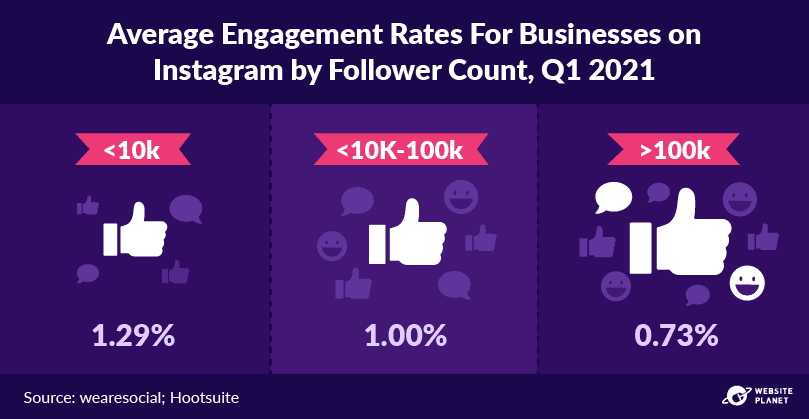 Does having a bigger following improve engagement? Well yes… but, kind of no…
Let me explain. Hootsuite’s research shows that smaller accounts receive higher levels of engagement per user. Accounts with less than 10k followers have an engagement rate of 1.29%, which means you can see tangible growth and connection with your customers, even in the early stages of a business account.
As a business account gets larger, the engagement rate goes down to 0.73%. That means the average user would be engaging with a business account less frequently.
However, a larger audience will still result in a far greater amount of views, clicks, likes, and comments overall. This is why it’s still crucial to grow your reach on Instagram.
Does having a bigger following improve engagement? Well yes… but, kind of no…
Let me explain. Hootsuite’s research shows that smaller accounts receive higher levels of engagement per user. Accounts with less than 10k followers have an engagement rate of 1.29%, which means you can see tangible growth and connection with your customers, even in the early stages of a business account.
As a business account gets larger, the engagement rate goes down to 0.73%. That means the average user would be engaging with a business account less frequently.
However, a larger audience will still result in a far greater amount of views, clicks, likes, and comments overall. This is why it’s still crucial to grow your reach on Instagram.
34. Which Sectors Get the Most Engagement?
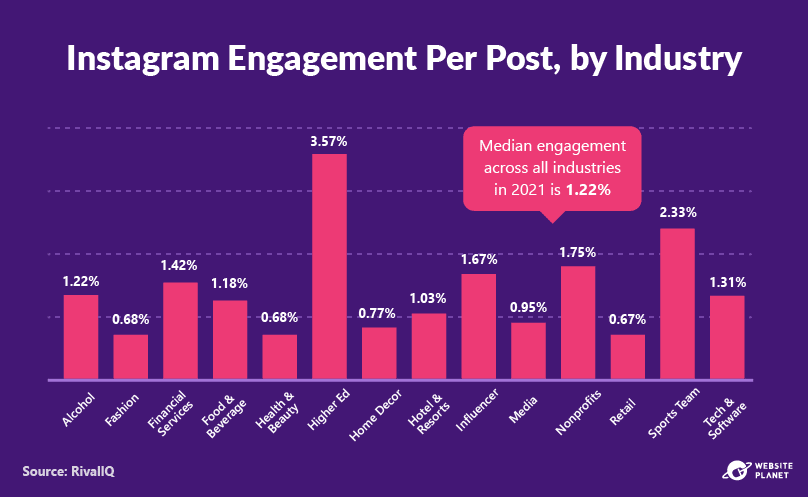 Rival IQ has crunched the numbers on Instagram engagement rates for each sector. Its research suggests higher education brands, such as universities, colleges, and Arts schools, receive the highest engagement amongst users.
This could have a lot to do with the way higher ed institutions use their platform — posting updates and student polls that are very relevant to followers. Sports fans love to engage with their favorite team’s content, too, while influencers get a healthy dose of engagement.
Surprisingly, fashion brands are way down on the list for engagement. They have an average engagement rate of 0.68%.
Overall, the business accounts included in Rival IQ’s study had a median engagement rate of 1.22% in 2021. That’s fallen significantly from 1.6% in 2020.
Rival IQ has crunched the numbers on Instagram engagement rates for each sector. Its research suggests higher education brands, such as universities, colleges, and Arts schools, receive the highest engagement amongst users.
This could have a lot to do with the way higher ed institutions use their platform — posting updates and student polls that are very relevant to followers. Sports fans love to engage with their favorite team’s content, too, while influencers get a healthy dose of engagement.
Surprisingly, fashion brands are way down on the list for engagement. They have an average engagement rate of 0.68%.
Overall, the business accounts included in Rival IQ’s study had a median engagement rate of 1.22% in 2021. That’s fallen significantly from 1.6% in 2020.
35. Instagram Is Best For Influencer Marketing
 Influencer marketers love to utilize Instagram’s culture of influencers, whether that’s through Stories or the Instagram feed.
Not much has changed on that front over the last year, despite the sharp rise of major competitors like TikTok. 97% of marketers said they would use Instagram for influencer campaigns at the start of 2020. In 2021, that figure decreased by just 4%.
That means Instagram and Instagram Stories remain the 2 most popular channels for influencer marketing. 70% of all social media influencers choose Instagram as their platform, so it’s no surprise to see Instagram top this list.
The range of visual content on Instagram means it is still the number one place for influencer marketers, a theme that doesn’t look like changing any time soon.
Influencer marketers love to utilize Instagram’s culture of influencers, whether that’s through Stories or the Instagram feed.
Not much has changed on that front over the last year, despite the sharp rise of major competitors like TikTok. 97% of marketers said they would use Instagram for influencer campaigns at the start of 2020. In 2021, that figure decreased by just 4%.
That means Instagram and Instagram Stories remain the 2 most popular channels for influencer marketing. 70% of all social media influencers choose Instagram as their platform, so it’s no surprise to see Instagram top this list.
The range of visual content on Instagram means it is still the number one place for influencer marketers, a theme that doesn’t look like changing any time soon.
36. Stories Are Important for Influencer Marketing
 Instagram Stories is the number one place influencers go to market sponsored content and materials.
This is expected. Instagram Stories is the most engaging part of Instagram, so it makes sense that marketers are getting influencers to post on Stories.
People like to tap on their favorite influencer’s Story regularly. The interactive features that are available on Stories only increase engagement and accessibility to a brand’s page. Influencers can include a “swipe up” call-to-action, for example, which takes users straight to the product/services being advertised.
Some businesses even go as far as handing their own Instagram Story over to an influencer. According to Klear, this can increase the chances of improving brand popularity by 14%.
Instagram Stories is the number one place influencers go to market sponsored content and materials.
This is expected. Instagram Stories is the most engaging part of Instagram, so it makes sense that marketers are getting influencers to post on Stories.
People like to tap on their favorite influencer’s Story regularly. The interactive features that are available on Stories only increase engagement and accessibility to a brand’s page. Influencers can include a “swipe up” call-to-action, for example, which takes users straight to the product/services being advertised.
Some businesses even go as far as handing their own Instagram Story over to an influencer. According to Klear, this can increase the chances of improving brand popularity by 14%.
37. What Other Types of Stories Do Brands Post?
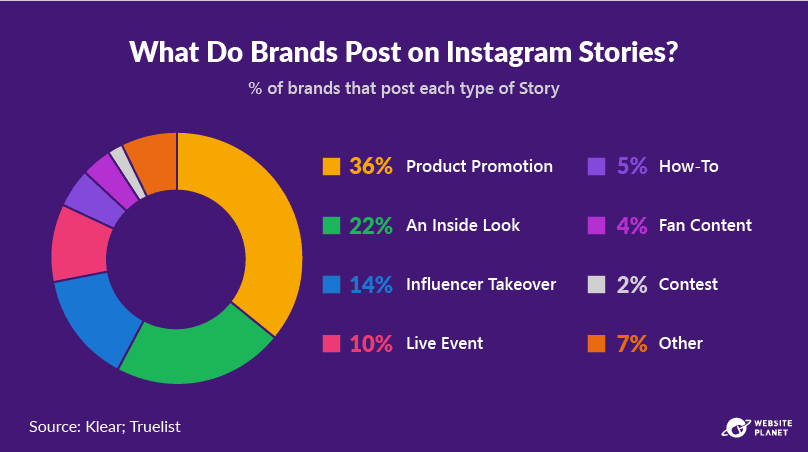 So, what else do brands post on their Instagram Story? Research from Klear reveals the most popular brand posts on the platform.
Product promotions take the mantle as the most popular brand post on Stories. 36% of business accounts post product promotions.
“Inside looks” (or “behind-the-scenes” videos) are really popular, with 22% of businesses posting them on Stories. Elsewhere, live events, influencer takeovers, and how-to videos are 3 more important types of branded Story content.
These results are pretty concurrent with what people want to see. It shows that brands are prioritizing value and quality with a lot of the content they’re posting, even if it is on Stories.
Klear’s study also found that brands post, on average, 2.5 times a week on Stories. So brands take their time releasing new content too!
So, what else do brands post on their Instagram Story? Research from Klear reveals the most popular brand posts on the platform.
Product promotions take the mantle as the most popular brand post on Stories. 36% of business accounts post product promotions.
“Inside looks” (or “behind-the-scenes” videos) are really popular, with 22% of businesses posting them on Stories. Elsewhere, live events, influencer takeovers, and how-to videos are 3 more important types of branded Story content.
These results are pretty concurrent with what people want to see. It shows that brands are prioritizing value and quality with a lot of the content they’re posting, even if it is on Stories.
Klear’s study also found that brands post, on average, 2.5 times a week on Stories. So brands take their time releasing new content too!
38. Do B2B Marketers Use Instagram?
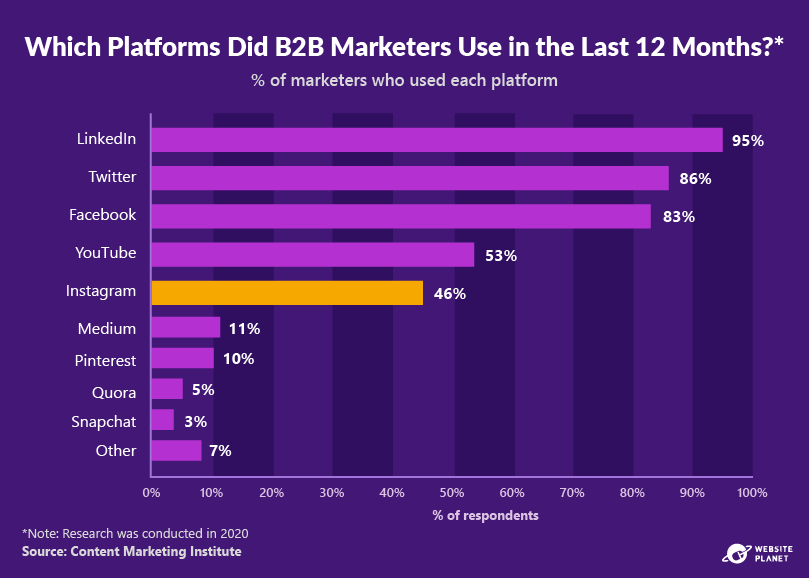 Do B2B marketers ever use Instagram? Not as much as some other platforms, according to the Content Marketing Institute.
46% of B2B marketers use Instagram, which is hardly insignificant. It ranks Instagram as the 5th most popular social media channel for B2B marketers, though platforms like LinkedIn, Twitter, and Facebook are used more often.
B2B marketers do use Instagram for other reasons, however. 36.2% of B2B decision-makers use Instagram for research, utilizing the platform to discover new brands and products for their business.
Do B2B marketers ever use Instagram? Not as much as some other platforms, according to the Content Marketing Institute.
46% of B2B marketers use Instagram, which is hardly insignificant. It ranks Instagram as the 5th most popular social media channel for B2B marketers, though platforms like LinkedIn, Twitter, and Facebook are used more often.
B2B marketers do use Instagram for other reasons, however. 36.2% of B2B decision-makers use Instagram for research, utilizing the platform to discover new brands and products for their business.
Instagram Marketing Best Practices
These are the “best practices” for Instagram marketing. Of course, we’ve already covered a range of trends that should give you a good idea of the subject. But here, we’ll be looking at the specifics of posting content on Instagram. How often should you post? When’s the best time to post? And how should you utilize each type of post on Instagram?39. How Often Should You Post?
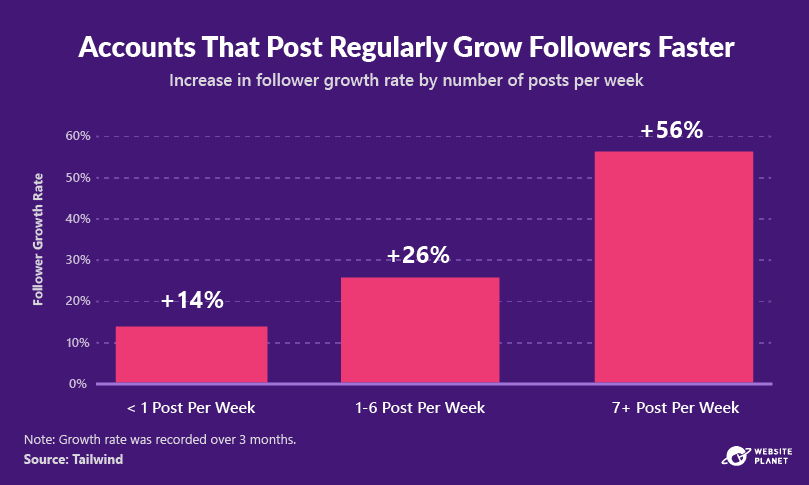 Tailwind has analyzed trends in the performance of Instagram accounts to show how often users should post.
According to Tailwind’s research, posting more regularly harbors the best results.
Accounts that post less than once a week don’t perform as well as others. Over a research period of 3 months, these accounts grew followers by 14%.
That’s significantly less than accounts that post more often. Accounts that post between 1 and 6 times per week can almost double the growth of their account. Posting more than once a day achieved a growth rate of 56% over 3 months. That’s impressive!
Tailwind has analyzed trends in the performance of Instagram accounts to show how often users should post.
According to Tailwind’s research, posting more regularly harbors the best results.
Accounts that post less than once a week don’t perform as well as others. Over a research period of 3 months, these accounts grew followers by 14%.
That’s significantly less than accounts that post more often. Accounts that post between 1 and 6 times per week can almost double the growth of their account. Posting more than once a day achieved a growth rate of 56% over 3 months. That’s impressive!
40. When Should You Post on Instagram?
 Research from Sprout Social shows the best times to post on Instagram.
There are a few times that generate great engagement in Sprout Social’s study — these are the periods where more users are generally more receptive to content.
People often check in to Instagram around midday, when they’re on their lunch break at work.
Engagement is high in this period, and on Tuesday user engagement remains high throughout much of the day. This is the best day for user engagement on Instagram.
The other big day for Instagram engagement is Friday. Again, users are most likely to engage with content around mid-morning/midday.
Sprout Social found that Sunday was the worst day for Instagram engagement amongst users.
A separate study from Sprout Social also found that Saturday is the best day for getting loads of likes. Note, this is not “overall engagement,” it is how many times users double-tap your post.
Research from Sprout Social shows the best times to post on Instagram.
There are a few times that generate great engagement in Sprout Social’s study — these are the periods where more users are generally more receptive to content.
People often check in to Instagram around midday, when they’re on their lunch break at work.
Engagement is high in this period, and on Tuesday user engagement remains high throughout much of the day. This is the best day for user engagement on Instagram.
The other big day for Instagram engagement is Friday. Again, users are most likely to engage with content around mid-morning/midday.
Sprout Social found that Sunday was the worst day for Instagram engagement amongst users.
A separate study from Sprout Social also found that Saturday is the best day for getting loads of likes. Note, this is not “overall engagement,” it is how many times users double-tap your post.
41. Which Type of Post Performs Best?
 Carousel posts are the best type of post for getting engagement on Instagram, ahead of images and videos.
Carousel posts can feature a selection of different images and videos within a swipeable post that users can navigate. People love to find out what’s included within a carousel, especially when it contains lots of diverse and interesting pieces of content.
Carousel posts had an engagement rate of nearly 2% in Socialinsider’s study, ahead of image-only posts (1.74%) and video-only posts (1.45%).
Similar research from Hubspot found that carousel posts get the highest median number of likes and comments compared to other post types, with video second and image third.
When Hubspot measured overall engagement across the 3 post types, its results were concurrent with Socialinsider’s.
Carousels are number one, followed by image, then video. This explains the growing popularity of carousels amongst marketers. You should try using them way more often if you don’t already.
Carousel posts are the best type of post for getting engagement on Instagram, ahead of images and videos.
Carousel posts can feature a selection of different images and videos within a swipeable post that users can navigate. People love to find out what’s included within a carousel, especially when it contains lots of diverse and interesting pieces of content.
Carousel posts had an engagement rate of nearly 2% in Socialinsider’s study, ahead of image-only posts (1.74%) and video-only posts (1.45%).
Similar research from Hubspot found that carousel posts get the highest median number of likes and comments compared to other post types, with video second and image third.
When Hubspot measured overall engagement across the 3 post types, its results were concurrent with Socialinsider’s.
Carousels are number one, followed by image, then video. This explains the growing popularity of carousels amongst marketers. You should try using them way more often if you don’t already.
42. Use Mixed Carousels
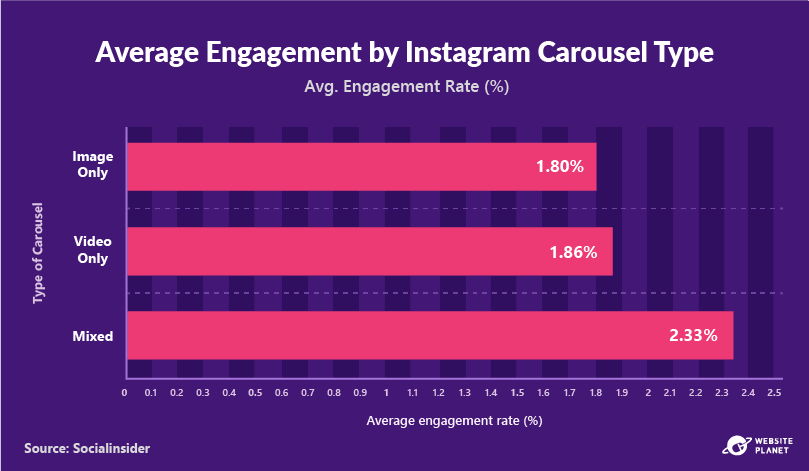 If you’re going to start using carousels, how should you go about it? Socialinsider reckons mixed carousels get way better engagement than image-only or video-only carousels.
Mixed carousels have an engagement rate of 2.33%, higher than video carousels (1.86%) and image carousels (1.80%).
That’s despite the fact that just 7.3% of carousels are mixed. 4% of carousels consist of videos, while 88.8% of them are image-only carousels. This shows that mixed carousels are underappreciated and underused, while the opposite is true for image carousels.
Marketers should use mixed carousels more often. Though, if you solely want to promote a discussion between customers, video carousels will work best. Video carousels get more comments per post than any other type of carousel (26.07).
If you’re going to start using carousels, how should you go about it? Socialinsider reckons mixed carousels get way better engagement than image-only or video-only carousels.
Mixed carousels have an engagement rate of 2.33%, higher than video carousels (1.86%) and image carousels (1.80%).
That’s despite the fact that just 7.3% of carousels are mixed. 4% of carousels consist of videos, while 88.8% of them are image-only carousels. This shows that mixed carousels are underappreciated and underused, while the opposite is true for image carousels.
Marketers should use mixed carousels more often. Though, if you solely want to promote a discussion between customers, video carousels will work best. Video carousels get more comments per post than any other type of carousel (26.07).
43. More Slides Work Better
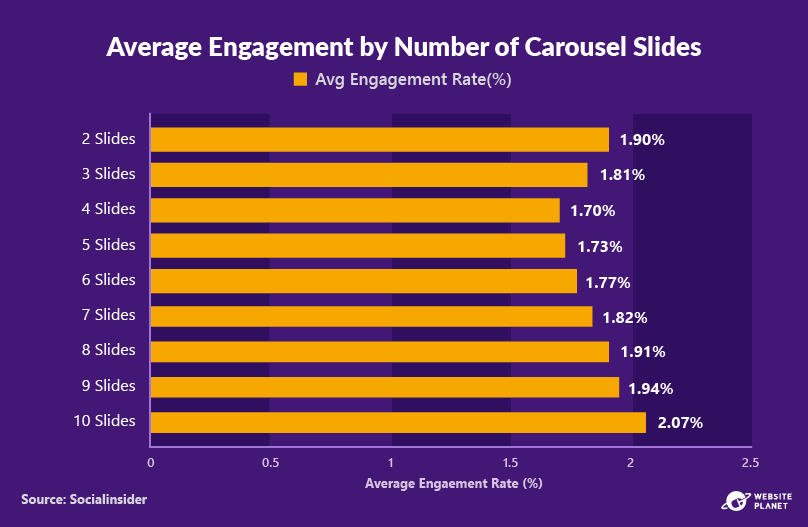 More slides work better in carousels, too. The research shows that 1 or 2 slides generate a good level of engagement (1.90% & 1.81%), while engagement drops off between 4 and 6 slides.
Post over 6 slides, however, and you’ll see engagement rise incrementally for each slide you add. When you max out at 10 slides in a carousel post, the average engagement rate reaches an impressive 2.07%.
Despite this evidence, most Instagram accounts are doing the opposite. 33.1% of carousels consist of only 2 slides, while just 6.77% of carousels are 10 slides long.
Longer carousels are better, then, and businesses should remember this when posting Instagram content.
P.S. Adding a swipe hint to a carousel is a good idea too. Prompting users to swipe through your content can increase a post’s engagement rate by over 9%.
More slides work better in carousels, too. The research shows that 1 or 2 slides generate a good level of engagement (1.90% & 1.81%), while engagement drops off between 4 and 6 slides.
Post over 6 slides, however, and you’ll see engagement rise incrementally for each slide you add. When you max out at 10 slides in a carousel post, the average engagement rate reaches an impressive 2.07%.
Despite this evidence, most Instagram accounts are doing the opposite. 33.1% of carousels consist of only 2 slides, while just 6.77% of carousels are 10 slides long.
Longer carousels are better, then, and businesses should remember this when posting Instagram content.
P.S. Adding a swipe hint to a carousel is a good idea too. Prompting users to swipe through your content can increase a post’s engagement rate by over 9%.
44. What Videos Do Users Watch?
 Video content is massively popular amongst Instagram users and has seen a meteoric rise in the last few years. In fact, Instagram claims it has seen an 80% increase in the amount of time users spend watching videos since the platform’s creation in 2013 .
Adding videos to an Instagram marketing strategy is crucial, but which type of videos do users want to see?
A Wibbitz survey found that trusty ‘how-to” videos are still the most popular type of video for Instagram users. People love to soak up information from the content they watch, and Instagram is no different.
Behind-the-scenes videos and interviews also scored highly, while motivational videos were not quite as popular as other types.
Video content is massively popular amongst Instagram users and has seen a meteoric rise in the last few years. In fact, Instagram claims it has seen an 80% increase in the amount of time users spend watching videos since the platform’s creation in 2013 .
Adding videos to an Instagram marketing strategy is crucial, but which type of videos do users want to see?
A Wibbitz survey found that trusty ‘how-to” videos are still the most popular type of video for Instagram users. People love to soak up information from the content they watch, and Instagram is no different.
Behind-the-scenes videos and interviews also scored highly, while motivational videos were not quite as popular as other types.
45. When Do Users Watch Videos?
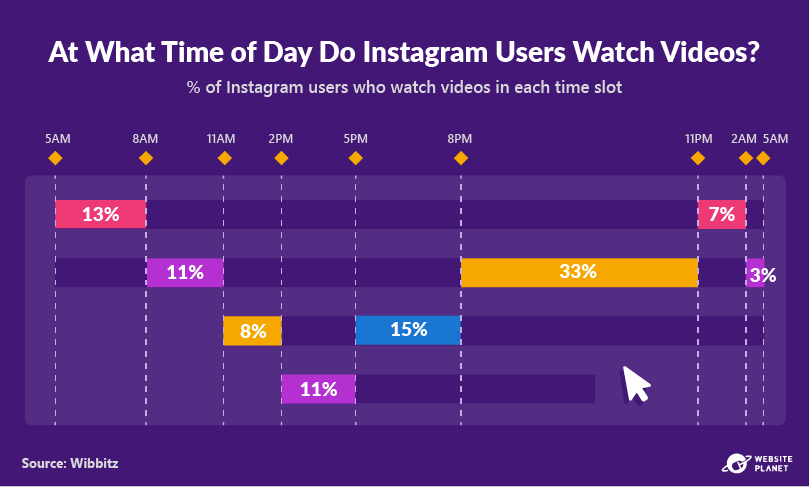 When you’re posting videos on Instagram, it’s probably best if you post around “prime time.” That’s when more users are online watching videos.
People love to engage with content around midday, but that’s not the case with videos.
Videos take more time and energy to consume than static images, so it makes sense that people are only really watching them when they’ve got some free time.
Post videos from 8pm to 11pm. That’s when people are typically relaxing before bed, and are more likely to watch your video post until the end.
When you’re posting videos on Instagram, it’s probably best if you post around “prime time.” That’s when more users are online watching videos.
People love to engage with content around midday, but that’s not the case with videos.
Videos take more time and energy to consume than static images, so it makes sense that people are only really watching them when they’ve got some free time.
Post videos from 8pm to 11pm. That’s when people are typically relaxing before bed, and are more likely to watch your video post until the end.
46. Short Videos Work Best
 According to research from BigCommerce, short videos work best on Instagram. In particular, try to keep your videos around 26 seconds long.
Short-form video is popular in 2021, and Instagram is no different. Whether it’s on Stories, IGTV, or simply via a normal post, keeping your videos shorter is likely to see positive results. No one wants to sit through a 20-minute epic! (Unless it’s really, really good).
According to research from BigCommerce, short videos work best on Instagram. In particular, try to keep your videos around 26 seconds long.
Short-form video is popular in 2021, and Instagram is no different. Whether it’s on Stories, IGTV, or simply via a normal post, keeping your videos shorter is likely to see positive results. No one wants to sit through a 20-minute epic! (Unless it’s really, really good).
47. User Generated Content is the Most Popular
 When it comes to image posts on Instagram, publishing user-generated content (UGC) should be your main priority.
User-generated content is content that has been created by customers for a brand or business. This could be in the form of fan-made graphic design work, photographs of products and branded events, or even written reviews.
Posting this type of content builds a deep connection between the Instagram account/business and the viewer. It presents brands as authentic and connected with their followers/customers. It’s a form of word-of-mouth marketing, or social proofing, that serves to generate intrigue and respect for your account.
That’s why UGC posts drive super-high engagement on Instagram. This results in a 4.5% increase in conversions.
According to AdEspresso, DIY images and behind-the-scenes images are two more popular forms of image post on Instagram.
When it comes to image posts on Instagram, publishing user-generated content (UGC) should be your main priority.
User-generated content is content that has been created by customers for a brand or business. This could be in the form of fan-made graphic design work, photographs of products and branded events, or even written reviews.
Posting this type of content builds a deep connection between the Instagram account/business and the viewer. It presents brands as authentic and connected with their followers/customers. It’s a form of word-of-mouth marketing, or social proofing, that serves to generate intrigue and respect for your account.
That’s why UGC posts drive super-high engagement on Instagram. This results in a 4.5% increase in conversions.
According to AdEspresso, DIY images and behind-the-scenes images are two more popular forms of image post on Instagram.
48. Simple Image Elements Go a Long Way
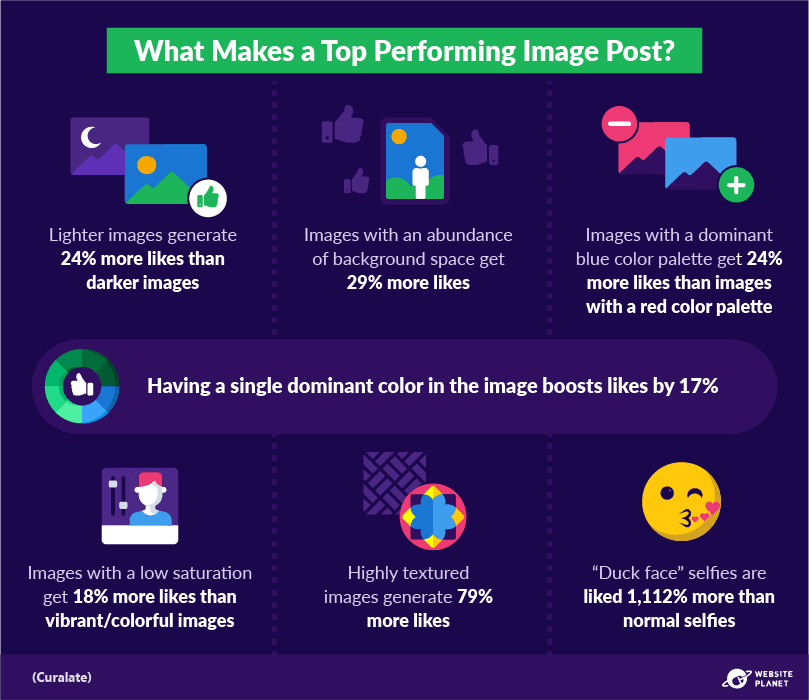 Curalate’s long list of image elements should give you a great idea of how you can boost the productivity of image posts on Instagram.
In general, the stats show that simplistic and stylish elements go a long way on Instagram.
Minimalistic frames with empty backgrounds generate 29% more likes, while a color-themed post can boost likes by 17%.
Meanwhile, washed-out, low-saturation shots resonate with Instagram users. These get 18% more likes than colorful images, which is opposite to what you might expect.
Textured images enjoy a massive boost in likes, while doing your best impression of a duck will garner the best results of all. This increases likes by a whopping 1,112%!
In general, posting selfies is a really good idea on Instagram…
Curalate’s long list of image elements should give you a great idea of how you can boost the productivity of image posts on Instagram.
In general, the stats show that simplistic and stylish elements go a long way on Instagram.
Minimalistic frames with empty backgrounds generate 29% more likes, while a color-themed post can boost likes by 17%.
Meanwhile, washed-out, low-saturation shots resonate with Instagram users. These get 18% more likes than colorful images, which is opposite to what you might expect.
Textured images enjoy a massive boost in likes, while doing your best impression of a duck will garner the best results of all. This increases likes by a whopping 1,112%!
In general, posting selfies is a really good idea on Instagram…
49. Add People (and Faces) to Your Images
 Research from the Georgia Institute of Technology and Yahoo Labs found that selfies are still really powerful on Instagram.
A study of over 1.1 million Instagram posts showed that people respond best to pictures of faces. That could be a long shot or a selfie. Either way, posts that feature faces get 38% more likes and 32% more comments than those without.
Who that face belongs to doesn’t seem to make a difference. Georgia Tech tested a range of faces, of different ages and genders, and all of them increased likes and comments by the same amount.
On a side note, try to sneak some emojis into your image posts. Doing so could increase engagement from 2.15% to 2.72%.
Research from the Georgia Institute of Technology and Yahoo Labs found that selfies are still really powerful on Instagram.
A study of over 1.1 million Instagram posts showed that people respond best to pictures of faces. That could be a long shot or a selfie. Either way, posts that feature faces get 38% more likes and 32% more comments than those without.
Who that face belongs to doesn’t seem to make a difference. Georgia Tech tested a range of faces, of different ages and genders, and all of them increased likes and comments by the same amount.
On a side note, try to sneak some emojis into your image posts. Doing so could increase engagement from 2.15% to 2.72%.
50. Keep It Simple On Stories
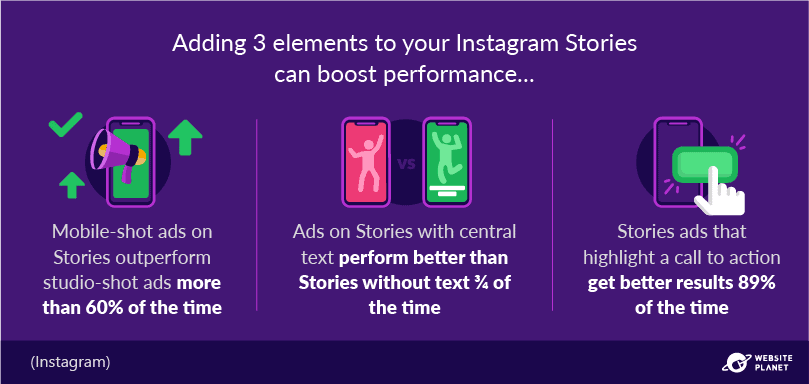 Simplicity and clarity of communication count for a lot on Instagram Stories. You have a very short amount of time to capture the viewer’s attention, and even then it’s incredibly easy for a user to swipe off your ad in a second. So get the message across instantly.
These 3 elements to a Story should help you capture the viewer’s attention and deliver a crystal-clear message.
First of all, shoot your Stories on mobile. Stories are about interacting with other people, and no one wants to be confronted with a high-budget advertisement within this context. So keep it simple. A mobile-shot selfie video that imitates a Story will work nicely.
You also need to reaffirm the message in your Stories ad with on-screen text. This is going to help people know about your product or company straight away. From here, users can decide whether they want to keep listening. Fail to communicate what you’re saying, and users will likely skip your ad before it gets going.
Finally, emphasize the call to action. This may seem obvious, but reaffirming your CTA is going to boost performance by nearly 100%! A basic “swipe up” CTA will often do.
Simplicity and clarity of communication count for a lot on Instagram Stories. You have a very short amount of time to capture the viewer’s attention, and even then it’s incredibly easy for a user to swipe off your ad in a second. So get the message across instantly.
These 3 elements to a Story should help you capture the viewer’s attention and deliver a crystal-clear message.
First of all, shoot your Stories on mobile. Stories are about interacting with other people, and no one wants to be confronted with a high-budget advertisement within this context. So keep it simple. A mobile-shot selfie video that imitates a Story will work nicely.
You also need to reaffirm the message in your Stories ad with on-screen text. This is going to help people know about your product or company straight away. From here, users can decide whether they want to keep listening. Fail to communicate what you’re saying, and users will likely skip your ad before it gets going.
Finally, emphasize the call to action. This may seem obvious, but reaffirming your CTA is going to boost performance by nearly 100%! A basic “swipe up” CTA will often do.
51. Post Previews of Your IGTV
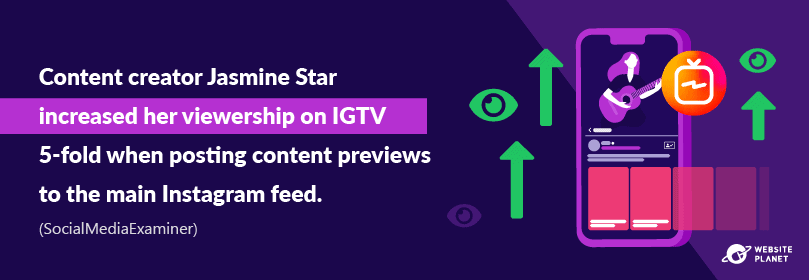 As mentioned, IGTV is by no means the most productive channel on Instagram at the moment, but that doesn’t mean it can’t still be effective.
The case of Jasmine Star is a good example of how IGTV could work for you. Jasmine is a content creator who primarily creates longer videos on YouTube.
When uploading videos to IGTV, the similarities between the 2 platforms meant her content could perform well. She optimized videos for vertical viewing on IGTV, seeing fantastic engagement as a result.
Instagram now lets you promote IGTV videos by posting a preview onto your main feed. This can return valuable results because IGTVs are not usually included on an account’s main posts page.
Jasmine Star, for example, saw 5X better viewership on her IGTVs when she published preview posts. So make sure you do the same!
As mentioned, IGTV is by no means the most productive channel on Instagram at the moment, but that doesn’t mean it can’t still be effective.
The case of Jasmine Star is a good example of how IGTV could work for you. Jasmine is a content creator who primarily creates longer videos on YouTube.
When uploading videos to IGTV, the similarities between the 2 platforms meant her content could perform well. She optimized videos for vertical viewing on IGTV, seeing fantastic engagement as a result.
Instagram now lets you promote IGTV videos by posting a preview onto your main feed. This can return valuable results because IGTVs are not usually included on an account’s main posts page.
Jasmine Star, for example, saw 5X better viewership on her IGTVs when she published preview posts. So make sure you do the same!
52. Instagram’s Algorithm Promotes Reels That…
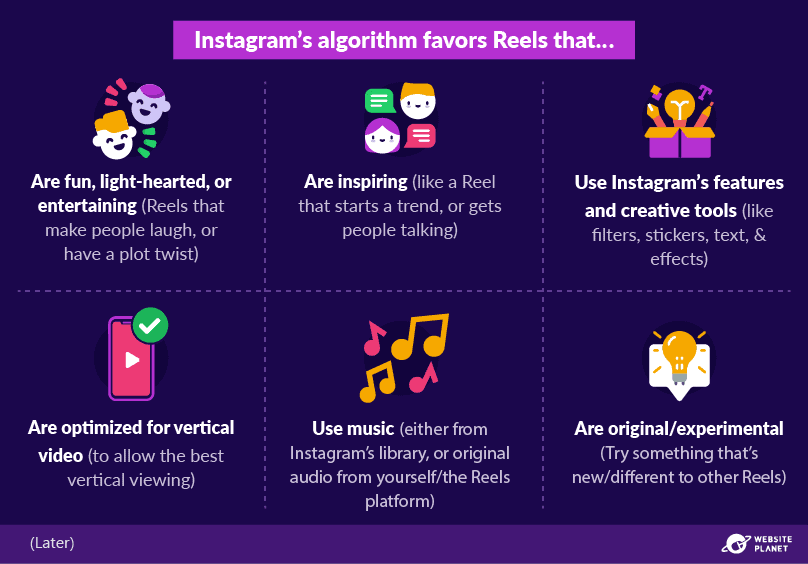 As we stated earlier, there’s a lack of great research into the effect of Instagram Reels at the moment. But we can take a look at Instagram’s algorithm to see what works and what doesn’t.
Reels are now available in over 50 countries, so it could well pay dividends if you can master this platform. All in all, Instagram will promote Reels that are entertaining, inspiring, creative, and experimental.
Instagram will also reward Reels that use music and creative tools. Brands that use the newest features in Reels will see their content pushed nearer the top as well.
However, some elements will see your Reels get penalized. Content that is recycled from other apps (like TikTok) will be less discoverable on the Reels page, especially if it is tagged with watermarks or logos from another app.
Low-resolution Reels, Reels with borders, Reels that are plastered with on-screen text, and Reels that don’t adhere to Instagram’s community guidelines will be penalized by Instagram’s algorithm, too — so avoid these elements!
As we stated earlier, there’s a lack of great research into the effect of Instagram Reels at the moment. But we can take a look at Instagram’s algorithm to see what works and what doesn’t.
Reels are now available in over 50 countries, so it could well pay dividends if you can master this platform. All in all, Instagram will promote Reels that are entertaining, inspiring, creative, and experimental.
Instagram will also reward Reels that use music and creative tools. Brands that use the newest features in Reels will see their content pushed nearer the top as well.
However, some elements will see your Reels get penalized. Content that is recycled from other apps (like TikTok) will be less discoverable on the Reels page, especially if it is tagged with watermarks or logos from another app.
Low-resolution Reels, Reels with borders, Reels that are plastered with on-screen text, and Reels that don’t adhere to Instagram’s community guidelines will be penalized by Instagram’s algorithm, too — so avoid these elements!
53. Plan Your Live Streams
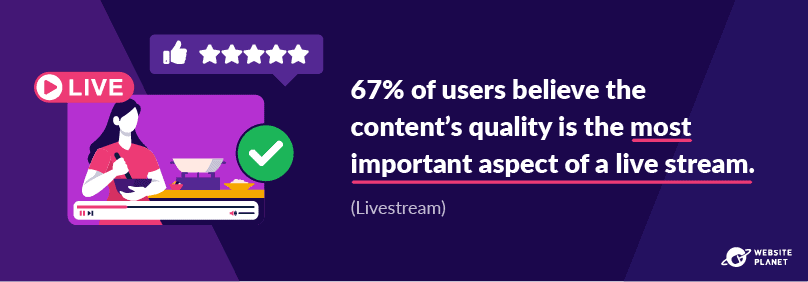 Making sure you produce quality content is the most important aspect of a live stream, according to a survey from Vimeo’s Livestream.com.
That means you have to be engaging on a live stream to get engagement from your post. Live-streaming may be easy to do, but that doesn’t mean you can give minimal effort and still expect results.
Instead, write down a list of great topics you can talk about before you live stream, or plan something fun to do while you’re “on air.” The same survey discovered that 87% of people love to watch “behind-the-scenes” live streams, so maybe a factory demo or house/office tour could be in order?
It’s certainly something you need to think about. People want to see live stream content from you or your brand. In fact, 82% of people prefer a brand’s live video to their standard social media posts.
Making sure you produce quality content is the most important aspect of a live stream, according to a survey from Vimeo’s Livestream.com.
That means you have to be engaging on a live stream to get engagement from your post. Live-streaming may be easy to do, but that doesn’t mean you can give minimal effort and still expect results.
Instead, write down a list of great topics you can talk about before you live stream, or plan something fun to do while you’re “on air.” The same survey discovered that 87% of people love to watch “behind-the-scenes” live streams, so maybe a factory demo or house/office tour could be in order?
It’s certainly something you need to think about. People want to see live stream content from you or your brand. In fact, 82% of people prefer a brand’s live video to their standard social media posts.
54. How Many Hashtags?
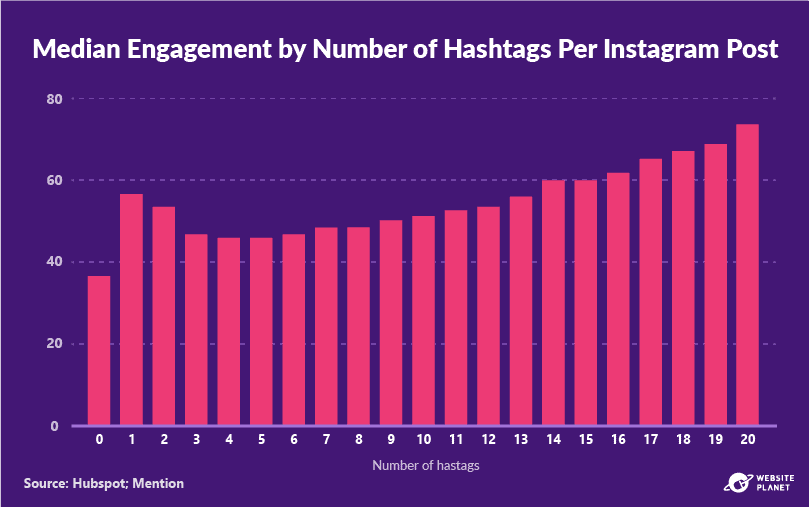 When it comes to regular posts, how many hashtags perform best? It’s an important question because 18% of people use hashtags to find brands on Instagram (Wibbitz).
Thankfully, it’s a question we can answer with the graphic above. According to Hubspot’s “Instagram Engagement Report,” posts with just one hashtag got roughly 20 more engagements than posts without a hashtag, so they’re definitely still useful.
Posting any number of hashtags is better than not using one. Posts that add between 2 and 13 hashtags still get improved engagement, but not quite as much engagement as posts with one hashtag. Get over the 13 hashtag mark, however, and engagement will increase incrementally with every hashtag you add.
The average number of hashtags across all Instagram posts is 6.93, which has decreased significantly since 2020 (10.74). Businesses could do with adding more hashtags to their posts. It can see results!
When it comes to regular posts, how many hashtags perform best? It’s an important question because 18% of people use hashtags to find brands on Instagram (Wibbitz).
Thankfully, it’s a question we can answer with the graphic above. According to Hubspot’s “Instagram Engagement Report,” posts with just one hashtag got roughly 20 more engagements than posts without a hashtag, so they’re definitely still useful.
Posting any number of hashtags is better than not using one. Posts that add between 2 and 13 hashtags still get improved engagement, but not quite as much engagement as posts with one hashtag. Get over the 13 hashtag mark, however, and engagement will increase incrementally with every hashtag you add.
The average number of hashtags across all Instagram posts is 6.93, which has decreased significantly since 2020 (10.74). Businesses could do with adding more hashtags to their posts. It can see results!
55. Which Hashtags Should You Use?
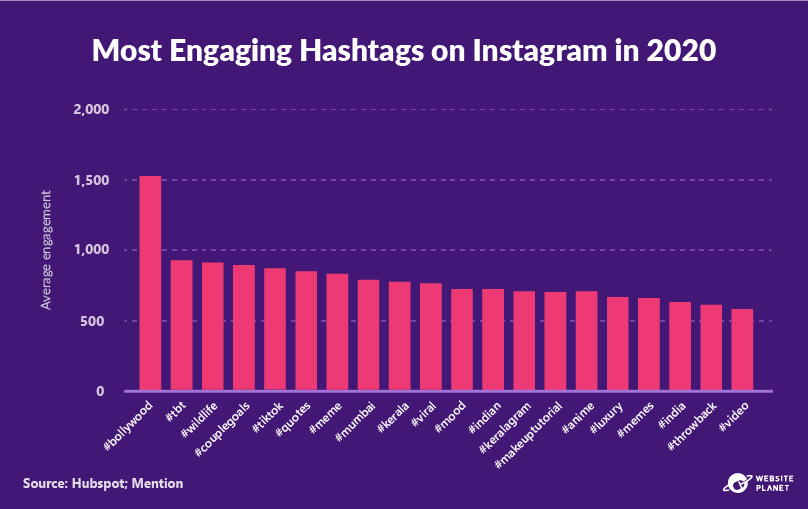 You cannot simply choose the most popular hashtags and expect to get the best performance. Popular hashtags will mean your post could get lost in an overcrowded results page, so be wary of using these.
For example, “#love” was by far the most used hashtag in 2020, but it gets nowhere near the top 20 most engaging hashtags. Neither does “#instagood” or “#photography,” 2 more popular hashtags. As a matter of fact, none of the top 20 biggest hashtags make it onto the chart of most engaging hashtags.
Instead, opt for one or more of the hashtags on the graphic above. These have been tried and tested as the most effective hashtags that generate user engagement.
Of course, make sure your hashtags are relevant to your post when using them. No one will want to engage with your post if it’s clickbait.
You cannot simply choose the most popular hashtags and expect to get the best performance. Popular hashtags will mean your post could get lost in an overcrowded results page, so be wary of using these.
For example, “#love” was by far the most used hashtag in 2020, but it gets nowhere near the top 20 most engaging hashtags. Neither does “#instagood” or “#photography,” 2 more popular hashtags. As a matter of fact, none of the top 20 biggest hashtags make it onto the chart of most engaging hashtags.
Instead, opt for one or more of the hashtags on the graphic above. These have been tried and tested as the most effective hashtags that generate user engagement.
Of course, make sure your hashtags are relevant to your post when using them. No one will want to engage with your post if it’s clickbait.
56. Tags Increase Engagement
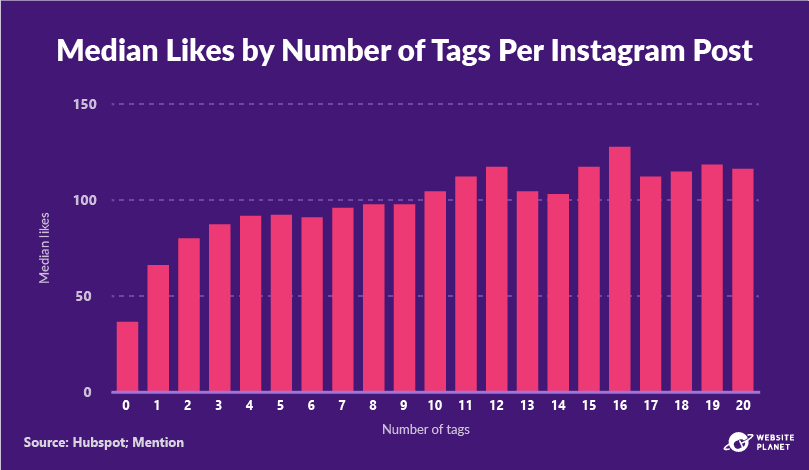 Tagging other people, brands, and accounts in your posts exponentially increases user engagement across the board.
Get Measured even found that adding another handle to your post can promote 56% more engagement, and those results certainly ring true with Hubspot’s study.
Adding one tag almost doubles the number of likes on a post. The more tags you add from this point onwards, the more likes a post generally receives. The sweet spot seems to be 16 tags. Posts with this number of tags performed best in Hubspot’s study.
Tagging other users and associated accounts generates a lot of intrigue for anyone who sees the post. They’ll follow tags to find out who the other accounts belong to.
Tagging other people, brands, and accounts in your posts exponentially increases user engagement across the board.
Get Measured even found that adding another handle to your post can promote 56% more engagement, and those results certainly ring true with Hubspot’s study.
Adding one tag almost doubles the number of likes on a post. The more tags you add from this point onwards, the more likes a post generally receives. The sweet spot seems to be 16 tags. Posts with this number of tags performed best in Hubspot’s study.
Tagging other users and associated accounts generates a lot of intrigue for anyone who sees the post. They’ll follow tags to find out who the other accounts belong to.
57. Geotag Your Posts
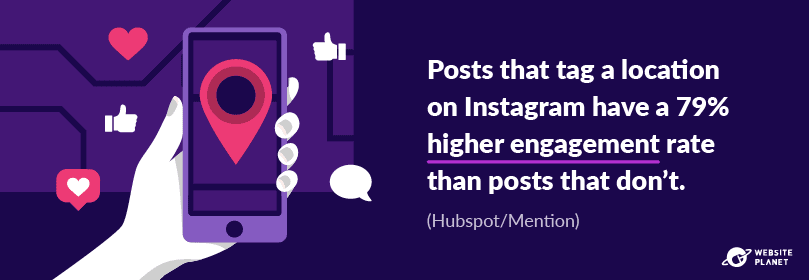 Another kind of tag can also have positive effects on engagement. Geotags boost the performance of Instagram content.
Geotags get great results for the same reasons that tags and hashtags perform. By adding a geotag, you’re creating intrigue, and people want to engage with your post further to find out specifically where that location is.
Adding a geotag places your post on a results page for that location too, just like adding a hashtag. Geotag results pages contain top-performing posts, so placing your content on these pages and ranking well can substantially boost traffic.
Another kind of tag can also have positive effects on engagement. Geotags boost the performance of Instagram content.
Geotags get great results for the same reasons that tags and hashtags perform. By adding a geotag, you’re creating intrigue, and people want to engage with your post further to find out specifically where that location is.
Adding a geotag places your post on a results page for that location too, just like adding a hashtag. Geotag results pages contain top-performing posts, so placing your content on these pages and ranking well can substantially boost traffic.
58. Shorter Captions Perform Best
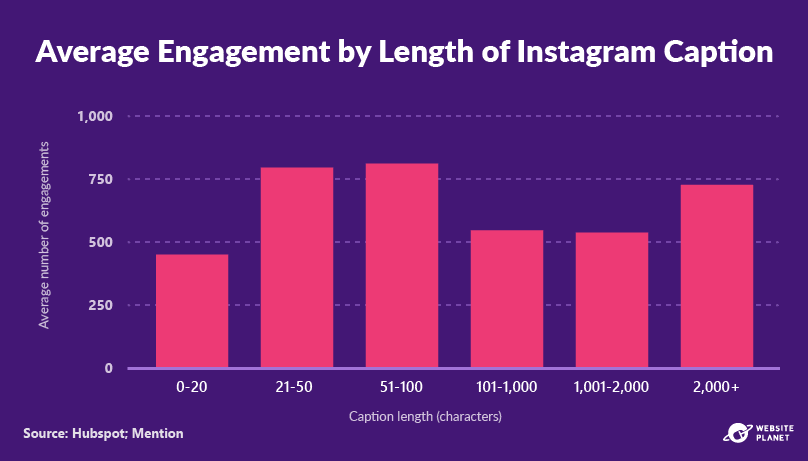 Shorter captions normally perform best, according to Hubspot and Mention.
Don’t use captions that are 20 words or shorter, however; really short captions receive the lowest number of average engagements.
Captions between 21 and 100 words perform the best by some distance. That being said, if you have an endless number of points to cover, writing 2,000+ words could be the way to go.
Engagement rises once you write this many words, though, you might be better served writing 2,000 words in a blog post rather than in an Instagram caption.
Shorter captions normally perform best, according to Hubspot and Mention.
Don’t use captions that are 20 words or shorter, however; really short captions receive the lowest number of average engagements.
Captions between 21 and 100 words perform the best by some distance. That being said, if you have an endless number of points to cover, writing 2,000+ words could be the way to go.
Engagement rises once you write this many words, though, you might be better served writing 2,000 words in a blog post rather than in an Instagram caption.
59. Optimize For the User’s Reaction
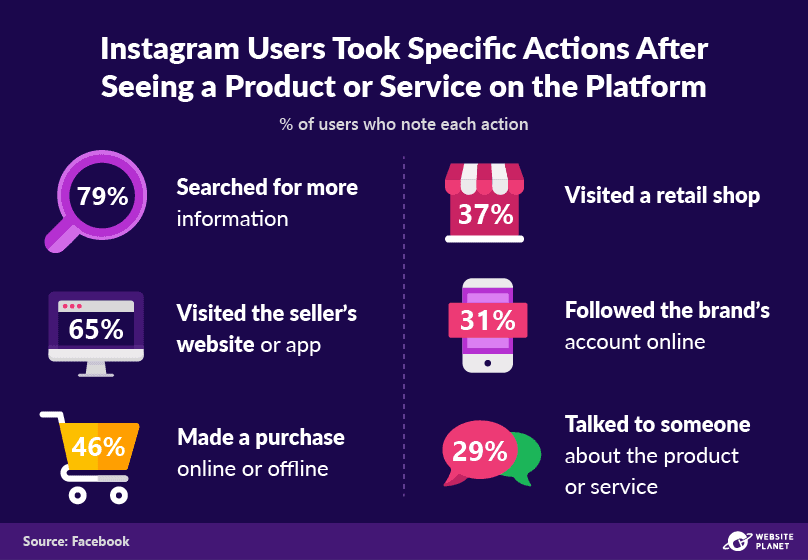 We’ll end with a couple of points about the buyer’s behavior. How do you prepare to make the customer’s journey as easy as possible?
The above research, conducted by Facebook, should give us a better idea of the ways a consumer might react to an advert or branded post.
79% of users reacted by searching for more information on the product. In which case, including a resource or explanation of the product somewhere in your content could make the buyer’s life a little bit easier. That could be in the form of an external link to a blog post, or you could simply explain the product in a caption.
29% of users talked to a friend about the product, so include a “tag your friends” or “share” prompt somewhere. 65% of respondents visited the seller’s website and 46% made a purchase, so optimizing that process will see big results, too…
We’ll end with a couple of points about the buyer’s behavior. How do you prepare to make the customer’s journey as easy as possible?
The above research, conducted by Facebook, should give us a better idea of the ways a consumer might react to an advert or branded post.
79% of users reacted by searching for more information on the product. In which case, including a resource or explanation of the product somewhere in your content could make the buyer’s life a little bit easier. That could be in the form of an external link to a blog post, or you could simply explain the product in a caption.
29% of users talked to a friend about the product, so include a “tag your friends” or “share” prompt somewhere. 65% of respondents visited the seller’s website and 46% made a purchase, so optimizing that process will see big results, too…
60. Include Swipe-Ups & Links
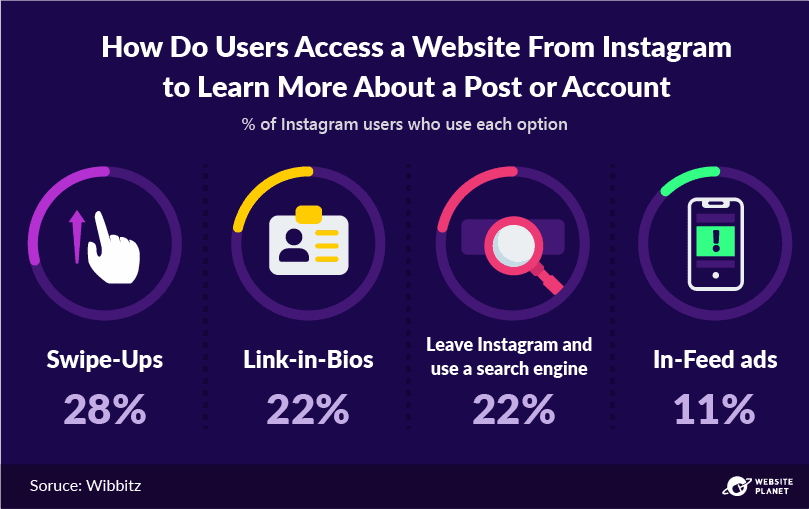 Include swipe-ups and links within your content and across branded accounts. These are a crucial part of the buyer’s journey on Instagram.
You certainly don’t want users leaving the platform to use a search engine. Doing so opens up several possibilities: the buyer could become distracted, could lose focus on what they’re searching for, or they could see a separate product/service that they choose to buy instead of yours.
Adding swipe-ups and links will make the buyer’s journey pain-free and seamless, which will result in better sales. Always draw attention to these elements through a call to action as well. This will make it glaringly obvious where the consumer needs to go.
Include swipe-ups and links within your content and across branded accounts. These are a crucial part of the buyer’s journey on Instagram.
You certainly don’t want users leaving the platform to use a search engine. Doing so opens up several possibilities: the buyer could become distracted, could lose focus on what they’re searching for, or they could see a separate product/service that they choose to buy instead of yours.
Adding swipe-ups and links will make the buyer’s journey pain-free and seamless, which will result in better sales. Always draw attention to these elements through a call to action as well. This will make it glaringly obvious where the consumer needs to go.








